Welcome to Grade 3B
“Education’s purpose is to replace an empty mind with an open one.”
-Malcolm Forbes

Form tutor – Ridhi Bansal
Co – Form tutor – Sayani Bhattacharya
“Education’s purpose is to replace an empty mind with an open one.”
-Malcolm Forbes

Form tutor – Ridhi Bansal
Co – Form tutor – Sayani Bhattacharya

The only thing that interferes with my learning is my education.
Albert Einstein
Unit of Inquiry
Students continued with their lessons on waste management with a visit to the sewage treatment plant in school and recorded their experience using procedural writing or a flow chart. This was followed by a group activity where they visited different areas of the school as part of small groups. They investigated and collected evidence (pictures) of various types of waste created in these places. They then analysed the pictures using a visual thinking routine of their choice. Students did a chalk talk activity where they analysed a valuable statement from stories read earlier and formed their opinion of the same. In the waste management lesson, they finished off by knowing about types of waste generated and how they can be managed. They participated in a group activity where they were given 2-3 scenarios to analyse how best waste can be managed.


























English
Students worked on their creative thinking where they learned to identify valuable statements from the article/story read to them while backing it with evidence. They honed their understanding of spell-bee words through a peer assessment activity. In tandem with their UOI waste management lesson, they learned co-construction of rubric and paragraph writing. For a similar unit integration lesson, they created “valuable statement” while reading the waste management article with the underlying thought “‘Waste for one person is necessity for another person”. There was a group activity where each batch was provided with 2-3 scenarios related to waste/3 R’s. Students analysed and discussed each scenario within their groups. The summative assessment for articles and pronouns as well as spelling was taken.




















Mathematics
Students were introduced to weight measurement through inquiry activity. They had to guess the weight of various objects presented to them which was followed by the actual weighing of the same articles. They learned about units of weight and their application in real life scenarios. Students understood conversion of units from their mentors from Grade 4. They explored online resources and read fact sheets to further understand the concept. Three stations were set up in class for different concepts (number operations, measurement, data handling/bar graph). Students were encouraged to visit each of them to reinforce or display their understanding while challenging themselves. During practice sessions students worked on unit conversion and word problems related to measurement of weight.



























Hindi
For Hindi, the students enhanced their listening skills while concentrating on the story “Abha ka Janamdin” and narrated the same to each other to improve their speaking skills. They encouraged their peers to hone their reading skills by viewing the same. They also identified words with different matras. To improve their writing skills, some wrote words from the story while others made sentences using those words. Some chose to use visual imagery. Students enacted the Hindi story “Billi ke Bachche” through role play.
Hindi ab-initio
During their Hindi lesson, students shared their views on the topic ‘मानव ने क्या बनाया और क्या बिगाड़ा’ through VTR –Tug of war. They revisited the concept ‘विराम चिह्न’ (punctuation marks) in grammar and enhanced their writing skills. Their knowledge was also assessed with their ability for sentences construction.









French
Learners were given the choice to decide on tasks for their portfolio of the Student Led Conference and Grade level assembly. They voiced their opinions and took ownership[KS1] . They enhanced their thinking skills (application), communication skills (listening and speaking) and social skills (supporting and cooperating with peers).
Spanish
Students read a story called “La Costa” which means The Coast and identified nouns in their singular and plural forms. This activity helped them build their reading skills by making connections with and beyond the text. Students also continued to give their inputs while working on their SLC portfolios.
Library
Students actively involved themselves in various activities like library scavenger hunt and part of speech bingo games during their library time. The student’s reading log was also assessed and counted this week to check their understanding on the books that were read and logged by them. Students were excited and looked forward to be make it to the year end crowned owl party.



PHE
Students understood and mastered the techniques of throwing and catching and were able to perform the necessary steps for the same. They played 6-A-Side handball match and made different formations for ‘STONE-PAPER-SCISSORS’ using hula hoops.




Art
Students discussed the different types of waste materials that can be used to create artwork. They then collected various plastic bottles and have started painting them to convert them into planters. This activity gave them the opportunity to develop their painting skills as they were exposed to acrylic paints for the first time.



Dance
Lessons were focused on advanced workouts to improve posture and flexibility which included combinations of stretching, jumping, spotting and plies. A discussion was held on the different types of props which could be created using waste material for the student’s dance performances.





Music
In class students learned about the form of a minor scale. They also learned the difference between a major and minor scale.




ICT
Using Minecraft, students created an effective waste disposal system in a city where most of the waste is recycled and the rest treated in an eco-friendly way. They learned to use inventory and craft items in Minecraft.



SEL
The concepts of Self-discipline and Self-control were reiterated through situation-based role-plays in class. A few examples helped students to identify and draw differences between self-discipline and self-control. Towards the end of the session, they were motivated to make a few lifestyle changes by focusing on goals that would help them achieve self-discipline in the classroom by displaying attention in class while the teacher is teaching, or being open to trying out different cuisines served in school, etc.






A mind is like a parachute. It doesn’t work if it’s not open.
Frank Zappa
Unit of Inquiry
Students began to explore the effect of waste on the environment as they observed a video on the types of waste such as industrial, agricultural, municipal/domestic and E- waste. They recorded their understanding of the effects of waste on animals, plants, crops, water and humans with the help of a mind map or note taking. Their understanding of the repercussions of plastic in the environment was presented through a medium of their choice – role plays, power point presentations and songs.
Through a bus stop activity, they were introduced to waste disposal methods (landfill, incineration, open dumping) and were excited to observe and guess the type of waste disposal method on each station. They used De Bono’s Yellow and Black hat to write about the advantages and disadvantages of each method.
They understood the effect of waste on human health (respiratory diseases, problem to ragpickers), plants and animals (leachate, contamination of crops and animal health). They went deeper into the topic as they learned about greenhouse gases and global warming through the visible thinking routine ‘Now I know’. Students eagerly created 7 stations outside the class based on the 7R’s of waste management.
Here’s Why Plastic Is SO MUCH Worse Than You Think!
How It Feels to Be an Ocean Animal Stuck in a Plastic Bag
20 kgs (45 pounds) of plastic removed from bull’s stomach in India
Video on incineration
Video on global warmingVideo on acid rain











Mathematics
Students improved their continuum of understanding about long division and division rules as they wrote their second understanding of the same. They were then introduced to word problems related to division. They undertook a Formative Assessment on Division where they chose tasks from three stations set up as- Must do, Can do, Can try.
They proceeded to reflect on their third understanding about division and word problems. They tuned into measurement as they discovered the exploration corner set up with objects related to the same concept. They introspected on their prior knowledge using the visible thinking routines ‘KWL’, ‘AQUA’ or ‘I see, I think, I wonder’.
Students were introduced to length and were thrilled to play the treasure hunt game using cues based on length. Also, they reflected on how they could apply their knowledge of measurement (length) in real life scenarios. They used their critical thinking skills as they learned about how the various units of length (mm, cm, m, km) are connected and can be converted. They understood the relationship between conversion, multiplication and division as they solved different task sheets.












English
Students were excited to show their understanding of subject and predicate and explored quizzes on their iPads. Integrating with the unit on waste, they read an article on the same and identified the subject and predicate in it. Further, they used a visible thinking routine ‘I used to think/now I think’ to reflect on their understanding of the same. Students were excited to watch and comprehend questions related to the story- ‘What Happens to Three Plastic Bottles’, after which they created a visual image of the journey of each bottle.
Students read a newspaper article on sewage systems and summarised it with paragraph writing. They were eager to present a one minute extempore speech as they chose a topic and prepared for it on the spot.
A formative assessment on novel study ‘Eyes of the Eagle’ was undertaken as they revisited the first three chapters and showed their understanding through a Tic-Tac-Toe game. They wrote down a paragraph/slogan as they interpreted cartoons of their choice and explained them through a visible thinking routine ‘What makes you say that’.
Students used their thinking skills as they made predictions to conclude a story by writing about it or through a role play as they read the comprehension passage in groups.
A story about what happens to 3 plastic bottles








Hindi
During their Hindi lesson, students watched a documentary on pollution with its various types, reasons and effects. They expressed their thoughts through the ‘SQUID’ strategy. They assessed their knowledge and self-management skills through a Hindi kahoot quiz . Students used their creativity to compose couplets and also created a unit related poem. Their knowledge of spellings was assessed through dictation.
Hindi ab-initio
To enhance their skills students listened to the Hindi story ‘Bilee ke bache’ and retold the same to augment their efficiency in speaking. To improve their writing skills student’s practiced ‘a’,’ai’, ‘o’ and ‘au’ maatras. To strengthen their reading ability they studied words with ‘a’ and ‘ai’ matraa.





French
Learners were given the choice to decide on tasks for their portfolio of the Student Led Conference and Grade level assembly. They voiced their opinions and took ownership. They enhanced their thinking skills (application), communication skills (listening and speaking) and social skills (supporting and cooperating with peers).
Spanish
Students worked on their SLC portfolios in groups and pairs. They used their self management and social skills while they communicated and created their profiles effectively by applying their knowledge of the target language.
Library
Since February 2000 International Mother Language Day is observed every year to promote linguistic and cultural diversity and multilingualism across the world. To mark International Mother Language day in the library, the students were acquainted with the purpose and importance of celebrating this event. They learned some widely spoken languages around the world like Chinese, Spanish, English and Hindi. The children shared the first language most commonly spoken at home some of which were Bengali, Punjabi, Gujarati, Korean, Chinese, Tamil and Haryanvi.


PHE
Students were introduced to throwing and catching, throwing while swinging the ball with both hands, stepping with the opposite foot as well as releasing the ball with two hands. They were made to practice ‘catching-stance’, catching a ball with both hands and dropping and catching a ball with two hands. They also played some recreational games.





Art
Students discussed how artwork could be created using different types of waste material. They have begun to collect various discarded plastic bottles which they will paint to convert into planters. This activity gave them the opportunity to develop their artistic skills as they were exposed to acrylic paints for the first time.


Dance
Lessons were focused on advanced workouts to improve posture and flexibility which included combinations of stretching, jumping, spotting and plies. A discussion was held on the different types of props which could be created using waste material for use by students during dance performances.


Music
Students learned about the form and function of major scale. They also learned finger placement to play a major scale using their right hand on the keyboard. They learned and practiced playing a major scale on keyboard.



ICT
‘Safer Internet Day’ was celebrated to promote the safe and positive use of digital technology amongst children. Students watched a visual presentation on internet safety that was followed by a class discussion. They shared suggestions on how to be safe online and created a mind-map about the ‘Dos and Don’ts’ of staying safe on the internet while using an iPad app.
Students were informed about the impact of e-waste on the environment and our health and its appropriate management through visual presentations and several online reports. After that, they proceeded to write their reflections on Padlet.






SEL
Reinforcement of the skill of self-control was reiterated through a video. This was followed by encouraging children to brainstorm and develop strategies on self-control in different scenarios through the application of the skill on a day to day basis. The students shared that the session empowered them to design a course of action on how self-control presents itself in the classroom, dining area and playtime.




International Mother Language Day






In learning you will teach, and teaching you will learn.
Phil Collins
Unit of Inquiry
The new unit on ‘Waste’ was introduced to third graders. The students divided themselves into three groups to observe images on waste, analyse slogans or read a poem on waste. They were given the liberty to opt for whatever category they liked and brainstormed different perspectives to enhance their understanding of each. This was followed by an activity where students read the central idea, identified the keywords, discussed their meaning and wrote their first understanding. They then illustrated their perception of the word ‘environment’. Using the strategy of ‘Chalk Talk,’ they discussed the first line of inquiry ‘and recorded their comprehension in the form of a mind map. Working in groups, students had to plan their research on air, water or land. They presented their findings in class and collated notes on all three types of waste. They revisited the central idea and wrote their second understanding on the unit.





















Mathematics
Students revisited bar graphs by plotting data and interpreting it. Students grouped themselves for the ‘herding game’ to better understand the concept of division. After this activity, students wrote their first understanding about the operation of division. They were introduced to vocabulary related to division and made a mind map of the same. Students built their understanding of division and tried using different strategies to divide numbers. They brainstormed with each other and understood the relationship between division and subtraction. They were also introduced to the concept of long division with and without remainders.












English
Students revisited opinion writing and were asked to express their thoughts about the country they would like to migrate to, if given a choice. They were introduced to couplets and poems and were taught that two rhyming lines make a couplet. They were encouraged to create their own couplets and poems.
They made real-life connections and used the ‘Avocado’ visible thinking routine to write and show their understanding of a poem by Ken Nesbitt. They employed the ‘traffic light strategy’ to reflect on their understanding of couplets and poems.










Hindi
In order to assess their prior knowledge students were given different pictures and poems. They formed groups entered detail in a VTR (The explanation game) after several rounds of discussion. They recited unit related poems and learned new vocabulary words to make sentences. Their knowledge of spellings was assessed with a dictation. They shared news articles related to waste and water.
Hindi ab-initio
The students enhanced their reading skills by reading words and sentences with ‘u’ maatraa. To improve their writing skills they participated in a spell bee of words and sentences with badee ‘u’ ki maatra. To hone their listening skills they listened to the story “Hans ka nayaay” and narrated the same to develop their speaking skills.








French
Students voiced their opinion during a group discussion where they shared what they would like to add, change or improve in their French language room. Taking ownership of their environment, the class set up their reading and games corner. They displayed their understanding of academic integrity in the form of a poster and also labelled various classroom objects. They enthusiastically played games like ‘hopscotch’ and ‘guess the number’ to revise concepts done in the previous term. They reflected on their learning and shared their AHA moments too.
Spanish
Students recapitulated the concepts of ordinal and cardinal numbers. They also had a class activity where they were made to read a small text in Spanish. They enhanced their reading and self-management skills and later identified vocabulary from the text.
Library
Students were given information on DDC (Dewey Decimal Classification) system. The Dewey Decimal System is the method of arranging books by subject and is the standard way of categorizing books in libraries across the world. It places books on shelves by subject using numbers from 000 to 999.
An activity was given to students where they matched the DDC numbers with its correct category. Children were informed about how DDC plays a vital role in categorizing and arranging books in libraries around the world.
PHE
Students practiced marching, running events, standing broad jump and medicine ball throw for the upcoming athletic meet. Participating in sporting events helps in building positive self- esteem and can be a great way to increase feelings of physical and mental well-being as was amply evident during practice schedules.
Art
Students inquired into positive and negative space and learnt to balance the two. Keeping this in mind they created a balanced work on Indo Islamic art using shades of one colour family (monochrome) to colour the background of their artwork.



Dance
Lessons focused on the introduction of elementary choreography and body isolations to better understand individual body motions. Students learned advanced workouts including combinations of turns, flips and establishments.




Music
Students were taught the music scale and how to locate music notes on a piano.
They also learned and sang the song “Yeh jo desh hai mera” by A.R Rahman.

ICT
Students worked on Minecraft to construct houses and items. They were introduced to MS PowerPoint. They learned how to open a new presentation and add new slides using different layouts. They also learned how to insert a picture into a slide.
SEL
Having self-control helps children in all areas of life. Being in control of their actions and reactions help them to develop good interpersonal skills to hone self-esteem. Focusing on this essential skill, children were guided to look back and review their performance during group activities that analyzed particular strands like-ability to stay on task, turn-taking, accepting other’s points of view, etc. This helped them understand the positive impact of practicing self-control for goal attainment.



“Education is not the learning of facts but the training of the mind to think.”
Albert Einstein
Unit of Inquiry
Students furthered their inquiry into the unit by finding out reasons that trigger rural to urban migration. They read an article on Migration in India and discussed why people from villages move to cities. They wrote their understanding of immigration, emigration, and migration. The students deliberated on immigration to the United States using a case study on mass migration during the California gold rush. They considered case studies to understand migrants, internally displaced, refugee and asylum seekers. They worked in pairs to research the impact of migration on the country of origin as well as the destination country. They presented their research work through a Visible Thinking Routine ‘Think Pair Share’. A parent shared her experience of migrating from Kashmir, interacting with her helped students better understand the emotional impact of migration and the push factors that precipitate it. The students themselves also exchanged stories about global, national and local migration and reasons for the same.
A million migrations: Journeys in search of jobs
Origins and Destinations of the World’s Migrants, 1990-2017
Forced to Flee – Children on the move


























Mathematics
The students strengthened their understanding of subtraction and were introduced to word problems with 2/3/4-digit sums with borrowing.
They were initiated into bar graphs by a pair activity ‘Knee to knee, eye to eye’ where they discussed terms related to graphs and why data in a graph is easier to understand than in tabular form.
They learned about the parts of a bar graph such as title, horizontal and vertical axis, scale and bars. Representation on a bar graph with a quick poll based on the students’ favourite seasons/pets/shoe sizes was interesting. Tally marks were used and results recorded to make bar graphs. The group activity on data collection where students reviewed information and made bar graphs aided practice with labelling, plotting and analysing bar graphs by examining data on their favourite after school activity.


English
The students were introduced to opinion writing using OREO strategy for opinion writing. They reflected on the story ‘Going North’ through a visible thinking routine and also presented their case study experience to the class. They observed that migration is an entirely individual experience with unique reasons and situations for different families. They took the initiative to create a checklist for opinion writing after a group discussion. The students were introduced to contractions. They discussed various contractions and root words that form them.









Hindi
During their Hindi lessons based on the migration unit, students viewed a video ‘आग वाली मछली’. They also attempted a ‘listen and tell’ activity which helped them to make meaningful connections. A read aloud story session, ‘रंगीन पक्षी’ helped them to enhance their reading and comprehension skills. Students displayed their thinking and self-management capabilities by working in groups.

Hindi ab-initio
The students enhanced their reading skills by studying words and sentences with ‘u’ maatraa. To strengthen their writing skills they participated in a spell bee of words and sentences with badee ‘ee’ ki maatra. To improve their speaking skill they played name, place, animal, thing, and learned sangya shabd. They watched a video of ‘Pitajee aur ghadha’ which they then narrated. They engaged in a roleplay of the story ‘Saras aur kenkda’.
French
Learners inquired and made connections about migration to France and other countries. They performed tasks in an organized manner and within the given time frame, hence developed their self-management skills. They listened, spoke, read and wrote new vocabulary words to enhance their communication skills.
Spanish
For Spanish lessons, students recapitulated self-introduction and learned the days of the week, months and seasons. Students were made to pay attention to an audio presentation and then asked to elaborate on the meaning of the words with its correct pronunciation.
Library
Students read and interpreted Carson Ellis’s award winning translanguaging book ‘Du Iz Tak?’ The picture book focussed on a group of bugs who discovered a new sprouting plant. They watched it grow and change through the seasons.
The uniqueness of this literary work , it’s imaginative use of language made interesting read. Students could only infer the meaning of the dialogues. They applied their thinking, and imagination to interpret and decode the language.
Students prepared a book using their understanding and a checklist that aided them to dabble in translanguaging. Guidelines like the story should have some made up language and illustrations must convey meaning of the story to the readers set expectations from the authors. The books created by students would be added to the Primary library collection for other children to read.
PHE
Students were introduced to ‘Athletics’ which involved sporting events that include competitive running, jumping, throwing, and walking. Athletics are commonly considered individual sporting events with the exception of relay races. Students practiced Athletic events like running, throwing and standing broad jump for the upcoming Athletic meet 2019-20.
Art
Students learnt about Indo Islamic art and created symmetrical patterns of the same using the line of symmetry. They also explored monochromatic art and have started to create a greeting card using monochromatic tones and Indo Islamic motifs.



Dance
Dance Lessons were focused on the development of rhythm patterns and flexibility. Warmups and exercises were done to improve control and have a sharp hold on the steps. Students learned a new dance routine on the song ‘Thousand Years’.






Music
In the class students learned and sang christmas songs and carols, they also revised on notes and note values.
Here are the links to the songs :


ICT
During coding students have learned to using loops and conditional blocks. ‘Scratch’ has been integrated with UOI wherein they programmed conversations between two sprites based on migration.




SEL
Students were involved in a group activity where they were encouraged to share positive attributes of their fellow peers. Each student was given a slip on which they were asked to write a good quality about the person whose name was written on it. This gave them the opportunity to understand and identify the strengths in others and created an atmosphere of unity and togetherness.
The roots of education are bitter, but the fruit is sweet.
Aristotle
Unit of Inquiry
In order to acquaint the class with the next unit on ‘Migration’, they were taken to the Sultanpur Bird Sanctuary. They participated in the ‘chalk talk’ activity where they worked in groups to discuss and write their awareness about the unit. Students operated in pairs to inscribe and share with others their understanding of the keywords from the central idea, ‘Human migration is a response to challenges and opportunities’. Later they brainstormed and recorded their interpretation of the term ‘migration’ using various visible thinking routines. For tuning into the first line of inquiry, the curious minds read articles and stories to question and comprehend the reasons for migration.
Relive a boy’s journey to America














Mathematics
While tuning in to subtraction, students were asked to write their perception of a problem using the visual thinking routine ‘What makes you say that?’ to come up with evidence to support their claim. They were introduced to horizontal subtraction using the ‘number line’ and ‘number bond’ strategies. They were made familiar with various terms related to subtraction. They learnt vertical subtraction with borrowing using ‘regrouping’ strategy and were guided towards the place value manipulatives to further enhance their grasp of the same.





English
Students listened to the story ‘Going North’ by Janice Harrington. They were also introduced to opinion writing during the week. They were divided into groups to discuss a case study from the testimonials on the website about children who have migrated to new places for various reasons.














Hindi
Students recited a poem ‘प्रवासी पक्षी’ (Prawaasee pakshee) which is related to the current unit of ‘Migration’. They learned new words from the poem and were able to form simple and meaningful sentences. They used a visible thinking routine Compass point (NEWS) and noted down their thoughts. Students participated in a ‘Listen and Tell’ activity on the topic of ‘Migration’.






Hindi ab-initio
To enhance their reading skills the students learned words with badee ‘e’ ki maatraa from their reading material. They participated in spell bee of words with badee ‘e’ maatraa. They watched and narrated a Hindi story- ‘Saras aur Kenkdaa’ to enhance their speaking skills. They used their imagination to visualize the anecdote to present a role play as members of groups.
French
Learners enthusiastically practiced the French version of the song ‘Together we can change the world’. They developed their social and communication skills while doing so.
Spanish
Students recapitulated the ordinal numbers in Spanish. They practiced a song through which students learned new vocabulary and were made to understand its meaning along with the correct pronunciation of each word. This whole activity helped students develop their social, thinking and communication skills.
Library
For the session on Academic Honesty, students were apprised about how to adhere to policies regarding academic writing and the written presentation of school work, especially in connection with plagiarism and related forms of academic misconduct. Academic honesty is a term used for professional honesty where credit should be given to work through references to sources that are being quoted, paraphrased or used in any other way. The code of conduct related to academic honesty is stipulated by rules and practices concerning the way in which work is carried out and reported.



PHE
For cricket lessons, students learned about hand eye coordination, the ability to throw and catch a ball, good batting and bowling techniques and the capacity to concentrate for longer periods of time. They engaged in cricket matches and were made familiar with the identities of sportspersons, coaches and instructors who had migrated from one place to another.











Art
Students used their creative thinking skills to produce a well coloured layout of the poem that they read on ‘Senses’. Most of them designed proportionate artwork and could express their understanding of the poem appropriately through their composition.



Dance
The class focused on discussions as to why dancers migrate from one place to another. For better flexibility students were encouraged to stretch their bodies to challenging limits.



Music
The students were enlightened about the impact of migration on music and reflected on the same. They also learned the song ‘Octopus’s Garden’.
ICT
Students were introduced to a block-based visual programming language ‘Scratch’. They learned to change the sprite and backdrop of the stage. They also used some basic code blocks to formulate the programming language.







SEL
Students were encouraged to build their self-esteem by reflecting on areas in which they excel. This was done through a method of self-actualization while working in pairs on a self-talk worksheet. This encouraged the students to think positively about themselves and introspect on their strengths.



An investment in knowledge pays the best interest.
Benjamin Franklin
Unit of Inquiry
To understand the correlation between the sense of smell and taste, students inquired about how they are connected while having breakfast. In addition, they further studied the different parts of the nose and tongue. The class performed an experiment to understand the role of saliva in tasting what they eat. They were made to dry their tongues with a clean paper towel and try a few samples of salt and sugar and were thrilled to discover that for us to savour taste, chemicals from the food must dissolve in saliva.
Integration with English ‘Procedural writing’, started with the ‘perfume experiment’ where students learned about the structure and functioning of the nose to sense the aromatic whiff. Further they learned about the composition and purpose of different parts of the skin as they labelled a diagram of the same. A discussion was then held on ways to take care of skin and keep it healthy.












English
Students read chapter three of their novel study and revisited pronouns. They were introduced to procedural writing through a listening activity where samples were read out, which led to a discussion on how they could be used in different situations. They enjoyed doing procedural writing using the bus stop activity where each group selected a topic related to a different bus stop. They referred to the checklist given to ensure their writing was correct. Integrating the unit on ‘Senses’ with language, the class revised the journey of light through the eye and the flow of sound waves through the ear. This was followed by procedural writing in the correct format for these sense organs.



Mathematics
Students practiced word problems with multiplication prior to which they were assessed on their understanding of the same. They focused on symmetry where they were given cut outs of different shapes and asked to fold them down the middle/horizontally/vertically. They were then asked to reflect on their understanding through the visible thinking routine ‘I see, I think, I wonder’. Symmetry was then introduced and discussed in detail by making real life connections to where it could be found in nature. The class watched a pesentation on Rangoli designs and enjoyed trying their hand at creating symmetrical displays with dots as guidelines. This helped enhance their creative thinking skills as they chose their own arrangements and coloured them. As an integration to the unit on senses, they made a symmetrical human face with special reference to placement of eyes, ears, nose and lips.








Hindi
Students were made to watch a documentary on Mother Teresa and Sunder Rajan Pichai in order to enhance their critical thinking and listening skills. They discussed reasons for migration. The class enhanced their speaking skills through ‘Bas Ek Pal’ activity on the topic of sense organs and their care. Knowledge of spellings was self-assessed through spell bee riddles.


Hindi ab-initio
To enhance their reading skills students studied words with chhotee ‘e’ ki maatraa. They participated in a spell bee of words with ‘e’ maatraa and then used them in sentences. They watched and recounted the story of ‘Char Brahman’ in Hindi to enhance their speaking skills. The class played a Bingo game with words containing ‘e’ maatra.

French
The objective of the French lesson was to peer-assess the knowledge acquired on numbers given in homework. It encouraged learner involvement and participation as the students engaged in thoughtful discussion while correcting their fellow classmates’ assignments under the supervision of the facilitator. They developed their thinking skills by applying their acquired knowledge and were caring and appreciative towards their associate’s achievements.
Spanish
Students learned the cardinal numbers from 1 to 50 and ordinal numbers from first to tenth. They were taught how to pronounce cardinal numbers and their difference in application to ordinal ones. Students also learned the uses of both kinds of numbers with their application in daily lives.
Library
Children were given information on DDC (Dewey Decimal Classification) system, which was created by Melvil Dewey in 1876. The Dewey Decimal System is used to arrange books by subject and is the standard method of categorizing volumes in libraries across the world. It places the books on the shelf by content, using numbers from 000 to 999. Children were informed how DDC plays a vital role in classifying books and their arrangements found in any library across the world. Students were acquainted with the categories that come under 000, 100, 200 and so on.
PHE
Introduction to circuit training is a fun and interactive way for children to be physically active. Fitness courses consist of setting up several stations with different events for students to rotate through in short periods of time. These include jump rope, hop scotch, throwing balls, shuttle runs, hula hoop, relay races, jumping jacks and dashes. Students engaged in various activities towards this end.






Art
Students read a poem on senses and reflected their understanding by creating a layout of an illustration for the verse. Some of them created their final work incorporating the given feedback on the arrangement.
Dance
For better flexibility, students were made to stretch their bodies to challenging limits through warm ups and exercises. Jumping, spotting, kicks and plies were practiced to improve posture.
Music
Students were divided into groups and were asked to create their own beats and note patterns. They enjoyed the activity and performed their own rhythms and melodies. The class was assessed on the basis of their individually created pattern and knowledge on the basis of Note Values. Students also learned and sang the first verse of the song ‘Octopus’s Garden’.
ICT
Students constructed merge cube which was used to view a 3D model of sense organs made in Paint 3D. They also learned to upload 3D items on the app: ‘miniverse.io’. The ‘object viewer app’ was also used to view articles on merge cube thereby enabling the students to experience augmented reality by designing their own models.
Social and Emotional Learning
The aim of the activity conducted this week was to promote the importance and relevance of kindness, compassion, and resilience. The students were empowered to identify and draw differences between these terms by sharing a few examples and discussing the links attached below. They were able to relate to the topic and were motivated to share a few examples related to kindness, resilience and compassion.





Unit of Inquiry
The unit on senses allowed students to explore the importance of the sense of hearing. They learned about the structure of the ear by observing diagrams and visual presentations. They also gained knowledge by visiting a biology lab and examining models of the eye and ear. Students were made to understand the functioning of the eardrum by performing an experiment which resulted in the conclusion that sound travels in waves.
Students presented research work about visually impaired people from India and across the globe who learned to overcome their challenge thereby showcasing international-mindedness.
Students also presented a chalk talk on challenges faced by people with auditory impairment.





















English
Integrating the unit on ‘Senses’, with language, the class was given the task of creating illustrations matching the written text. They were divided into groups and on the basis of the senses and drew pictures to match sentences. A ‘take and talk’ on the ear was shared by students in class. Students researched facts on how to protect their ears from electronic devices and books. They also read chapter three of the novel study ‘The Eyes of the Eagle’.




Mathematics
Students were introduced to multiplication of 2 digit numbers by being given a choice of using different ways to calculate i.e. through repeated addition, array method or by drawing pictures. Students used 1 and 2 digits as multipliers and practiced using 2 and 3 digit multiplicands.
They practiced word problems using CUBES strategy.




Hindi
In their Hindi lesson students presented prior knowledge on sense organs through role play and a visual thinking routine ‘Think-pair-share’. They enhanced their communication skills and visual imagery by listening to and reading a poem. They picked up naming words from a given picture and revisited grammar concepts वचन (singular-plural).
Hindi ab-initio
To enhance their reading skills the students recited words with ‘e’ in various sentences. In a spelling bee they wrote down words with ‘e’ maatraa. They watched the story- ‘The Elves and the Shoemaker’ in Hindi.

French
The objective of the French lesson allowed students to recapitulate their grammar and vocabulary and self-assess their homework to encourage learner involvement and participation. Thoughtful discussions helped them to correct their own work under the supervision of a facilitator.
Spanish
Students were introduced to the cardinal numbers 1-20 in Spanish. They were taught how to pronounce these numbers and how their enunciation changes with the use of accents on them. Students were made to listen to the numbers and write them on their own in order to avoid spelling mistakes and better their writing skills
Library
Students exchanged books and shared stories read by them in the previous week. On the occasion of ‘World Food Day’ which is celebrated worldwide on 16th October, a discussion was held on why we celebrate this significant date and how we can contribute to this worthy cause through a ‘zero food wastage’ policy.
This year the theme of the Food and Agriculture Organization of United Nations (FAO) is to help everyone make ‘healthy eating’ and ‘Zero Hunger’ a way of life through sustainable diets that can be afforded and accessed by everyone.
Physical Health Education
Our senses play an important role in yoga in different ways. They serve to navigate a connection between our brain and the environment.
Surya Namaskar also known as sun salutations, is an exercise practice in yoga incorporating a sequence of twelve gracefully linked asanas. Children performed the different formations of Surya Namaskar trying to keep the postures correct.
Art
Students were made to read a short poem on the senses and are learning how to create an artwork taking inspiration from the same.
ICT
Students constructed and labelled the different parts of a human ear on a digital 3D model. They learned the use of the 3D view tool to toggle between 2D and 3D views. In Paint 3D they learned to view controls as a reminder of how to control the position with different input devices.


Social and emotional learning
The aim of the activity conducted this week was to promote the importance and relevance of kindness, compassion, and resilience. The students were empowered to identify and draw differences between these terms by sharing a few examples and discussing the links attached below. They were able to relate to the topic and were motivated to share a few examples related to kindness, resilience and compassion.







” A winner is a learner who never gives up.”
Nelson Mandela
Unit of Inquiry
The week began by watching a demonstration on the making of the structure of an eyeball to better understand it’s working. The students were then asked to label the different parts of this sense organ.
By watching engaging videos, a more in-depth inquiry about the functioning of the various parts of an eye was undertaken. In their journals, the students then wrote their perceptions of the parts of an eye and their functions.
The learning progressed on to comparing and contrasting the functioning of the eye with a camera. The students learned that just like a camera, the eye also clicks pictures and sends them to the brain for analysis.
The students then discussed how to take care of eyes through an engaging group activity and visiting carousel stops.
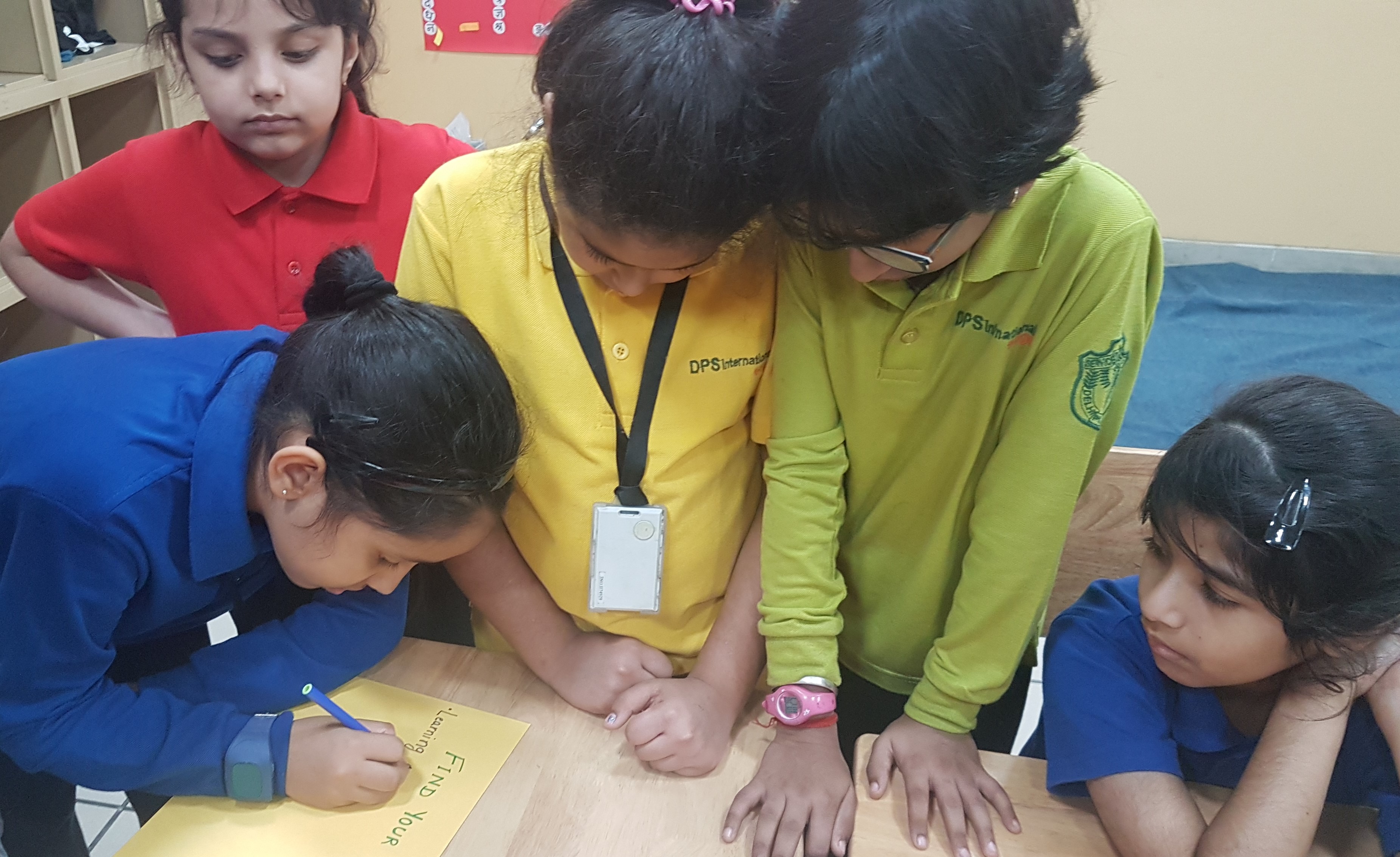
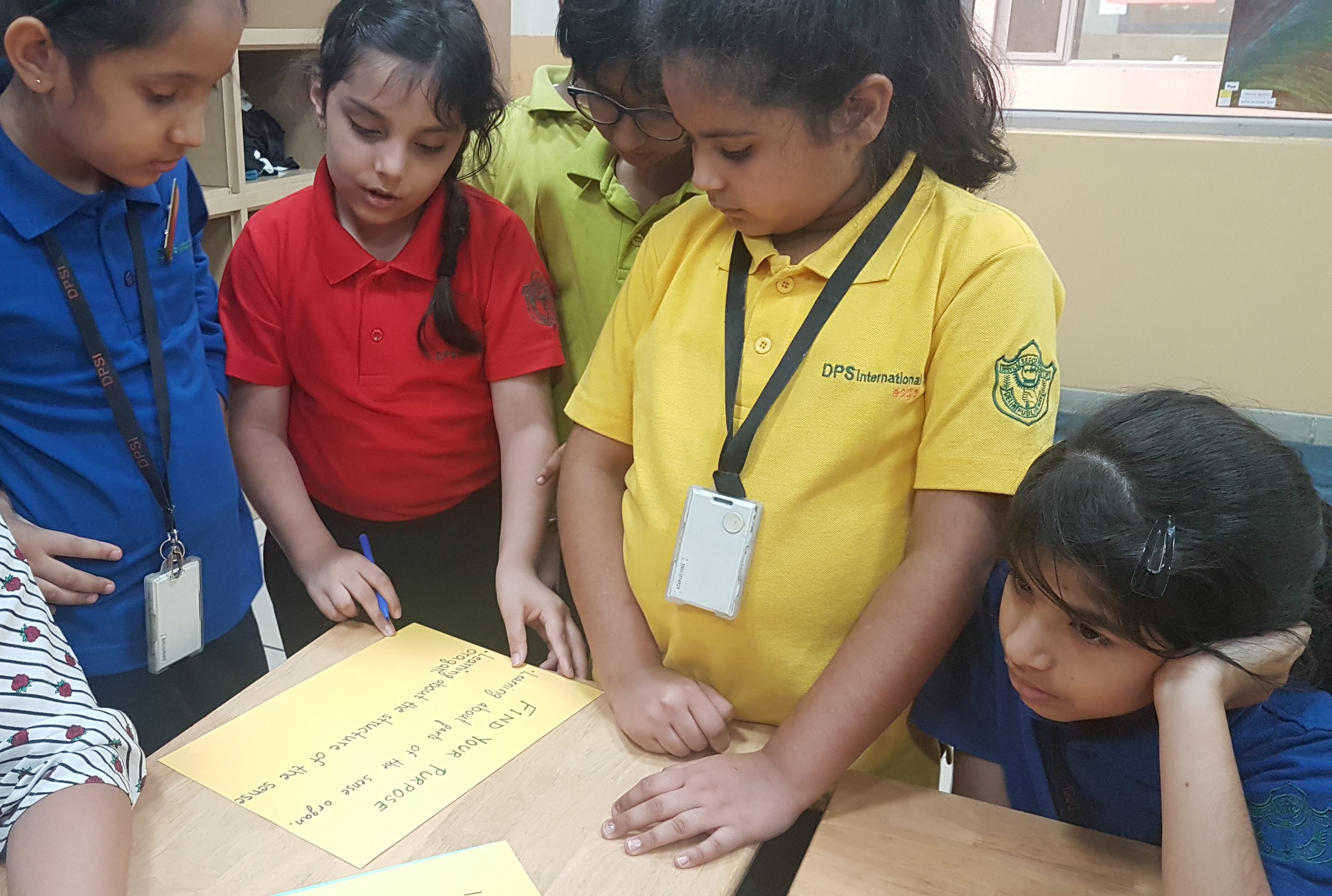



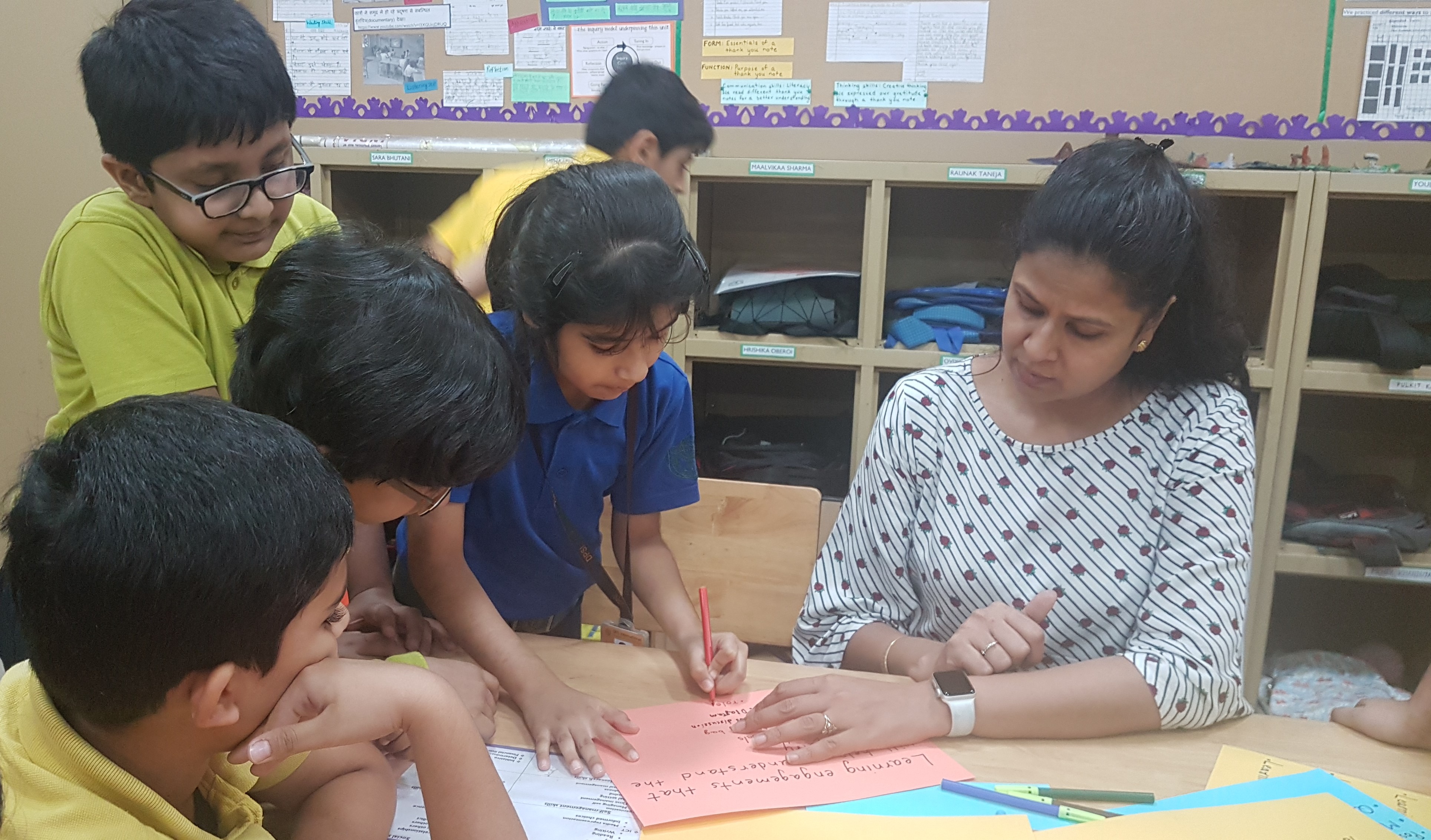
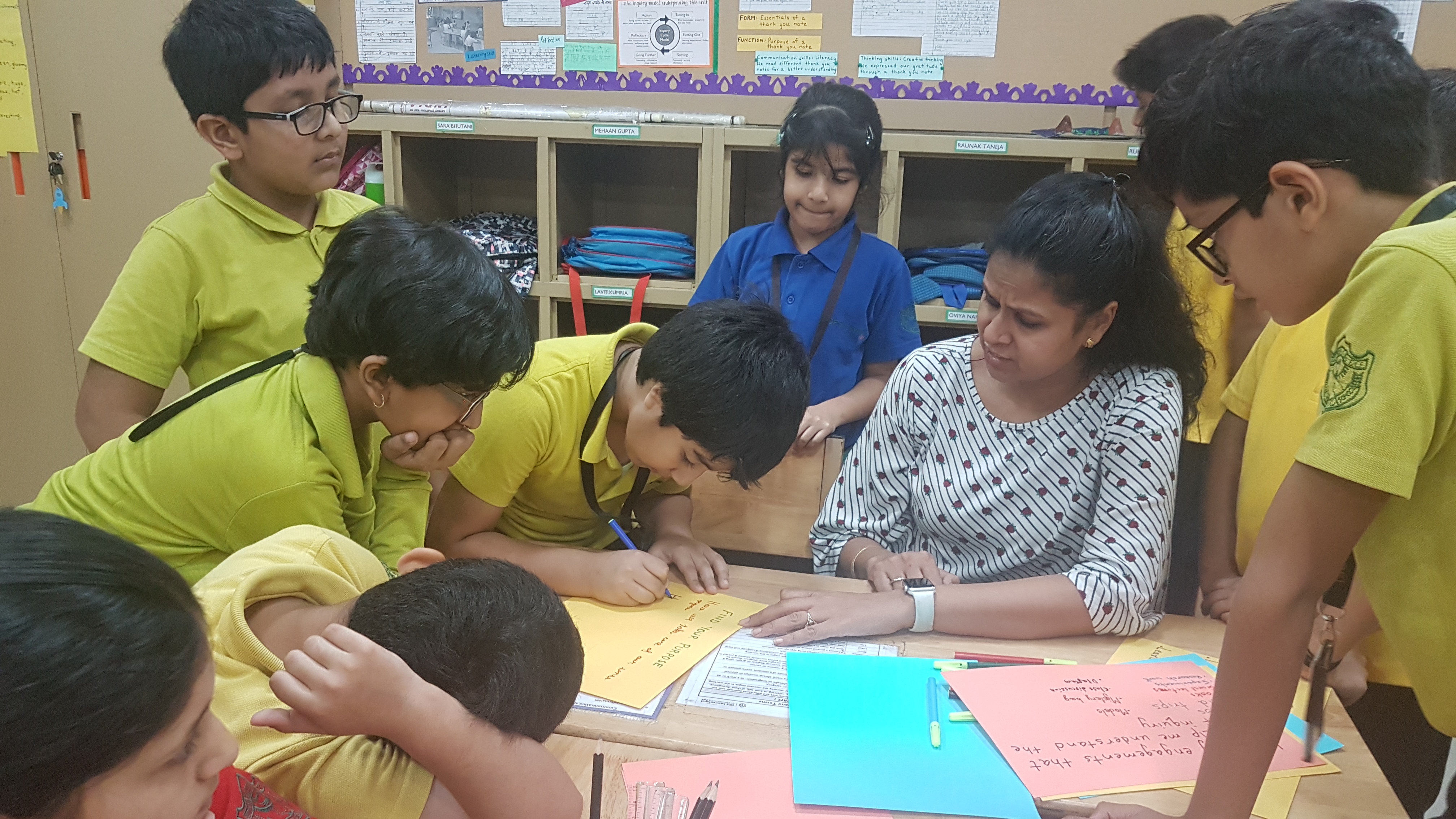

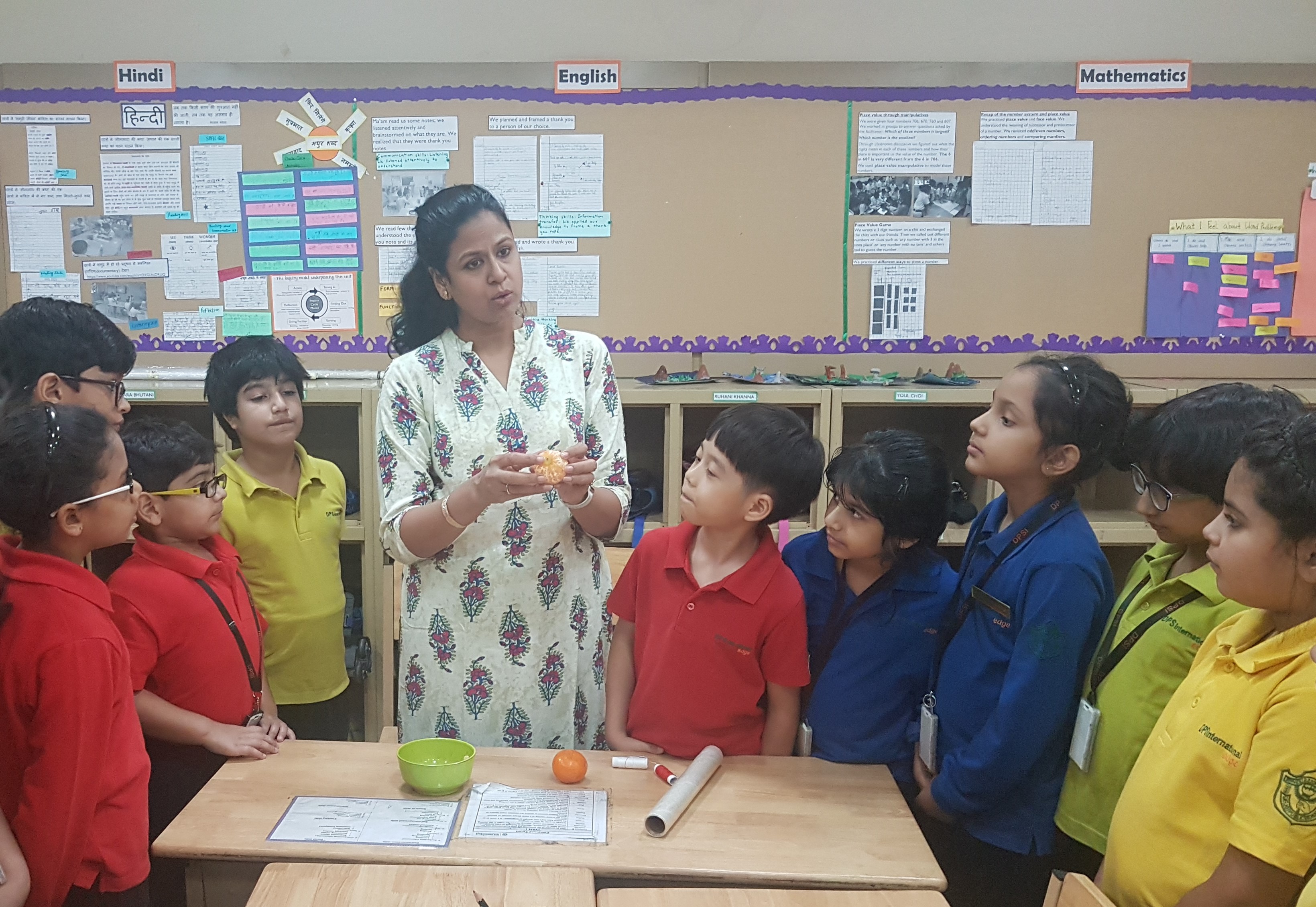


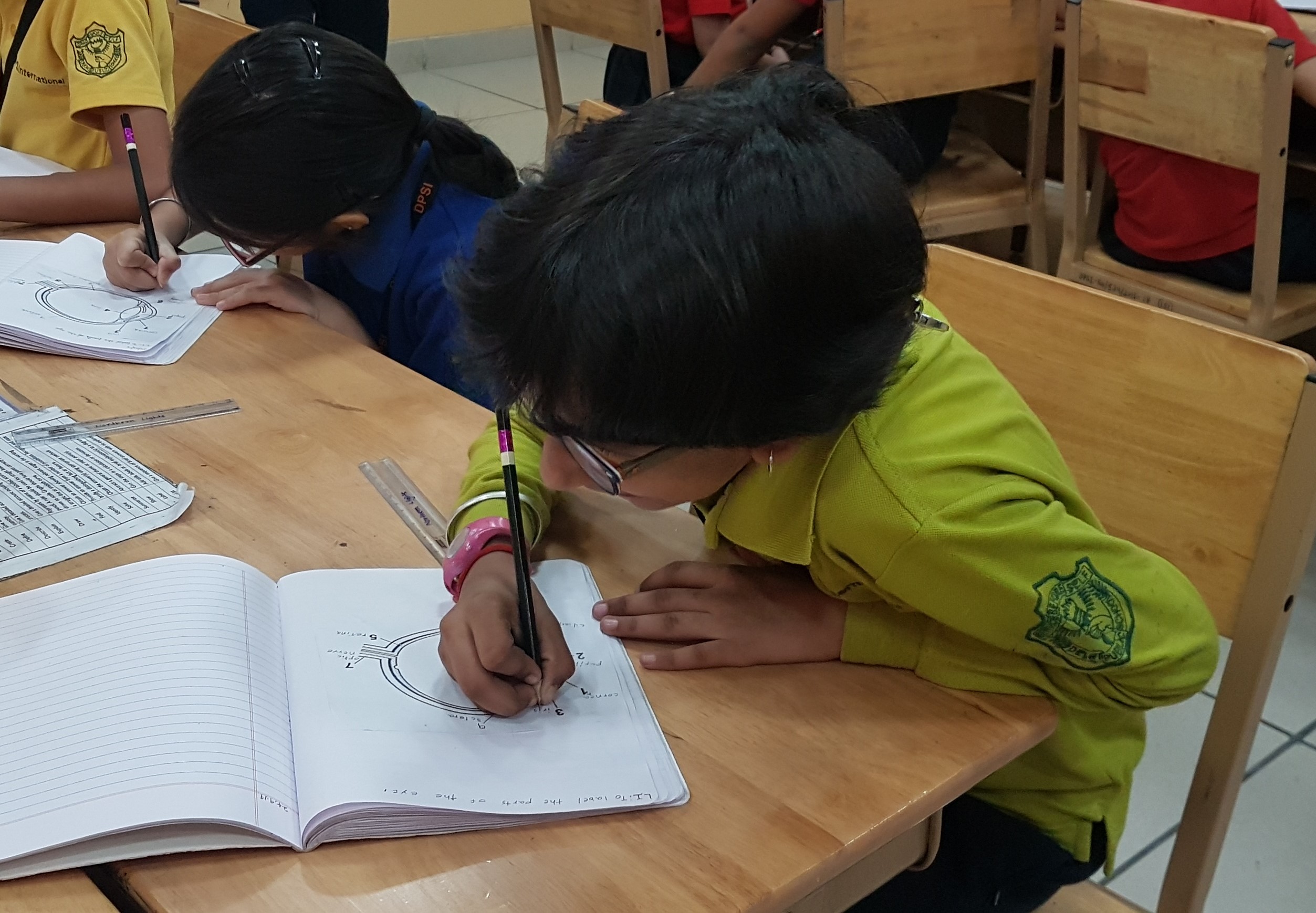
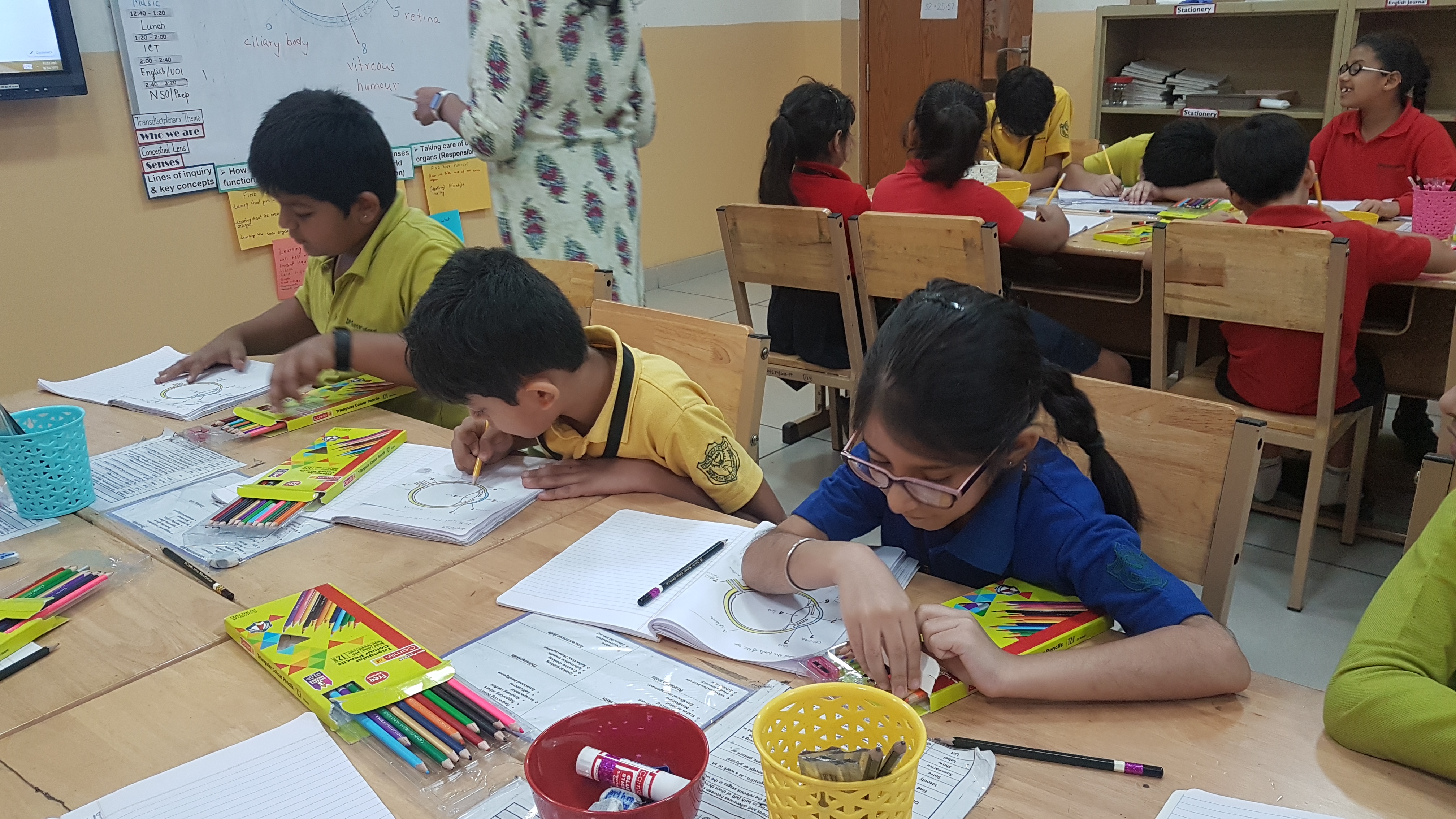


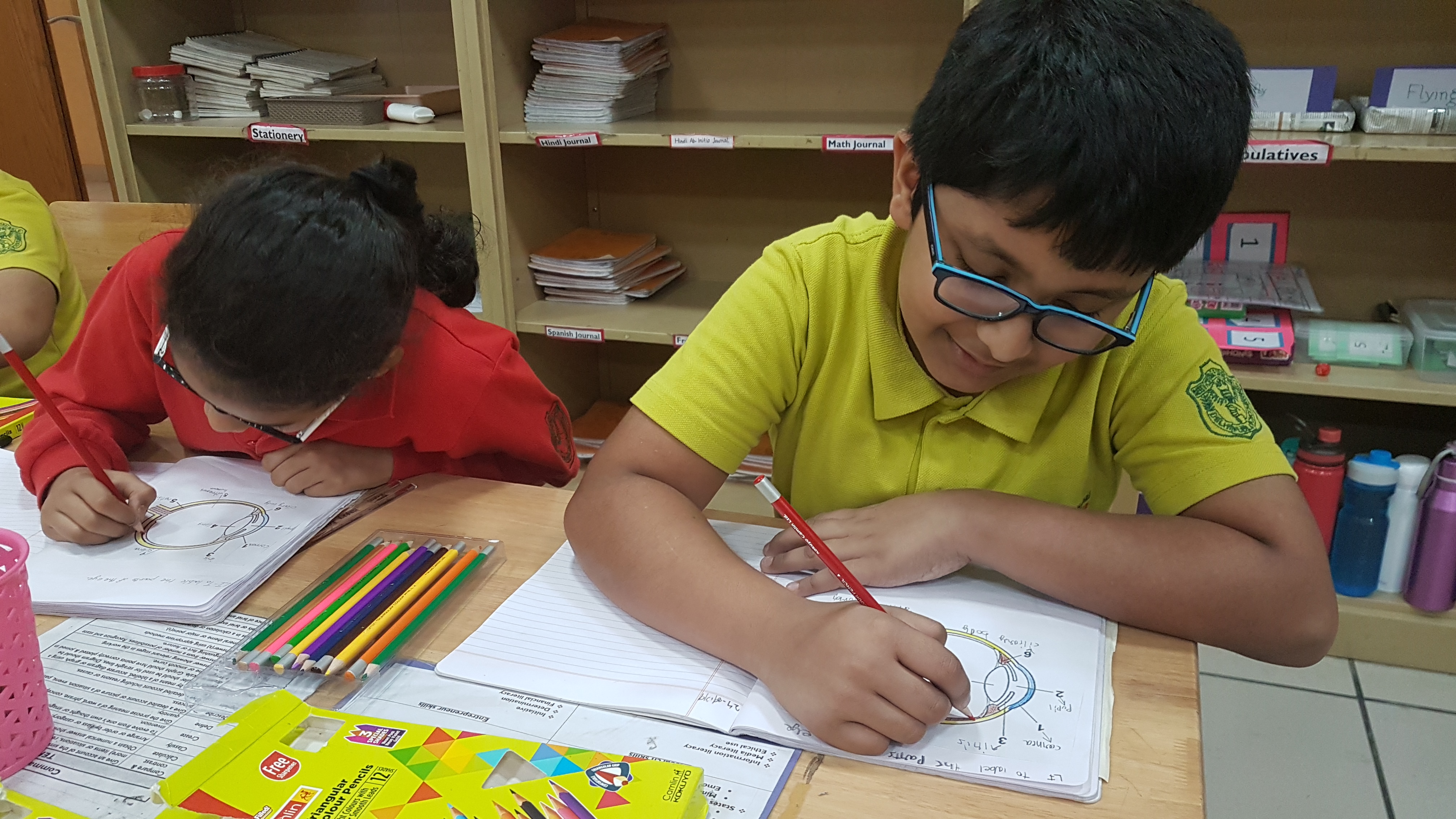
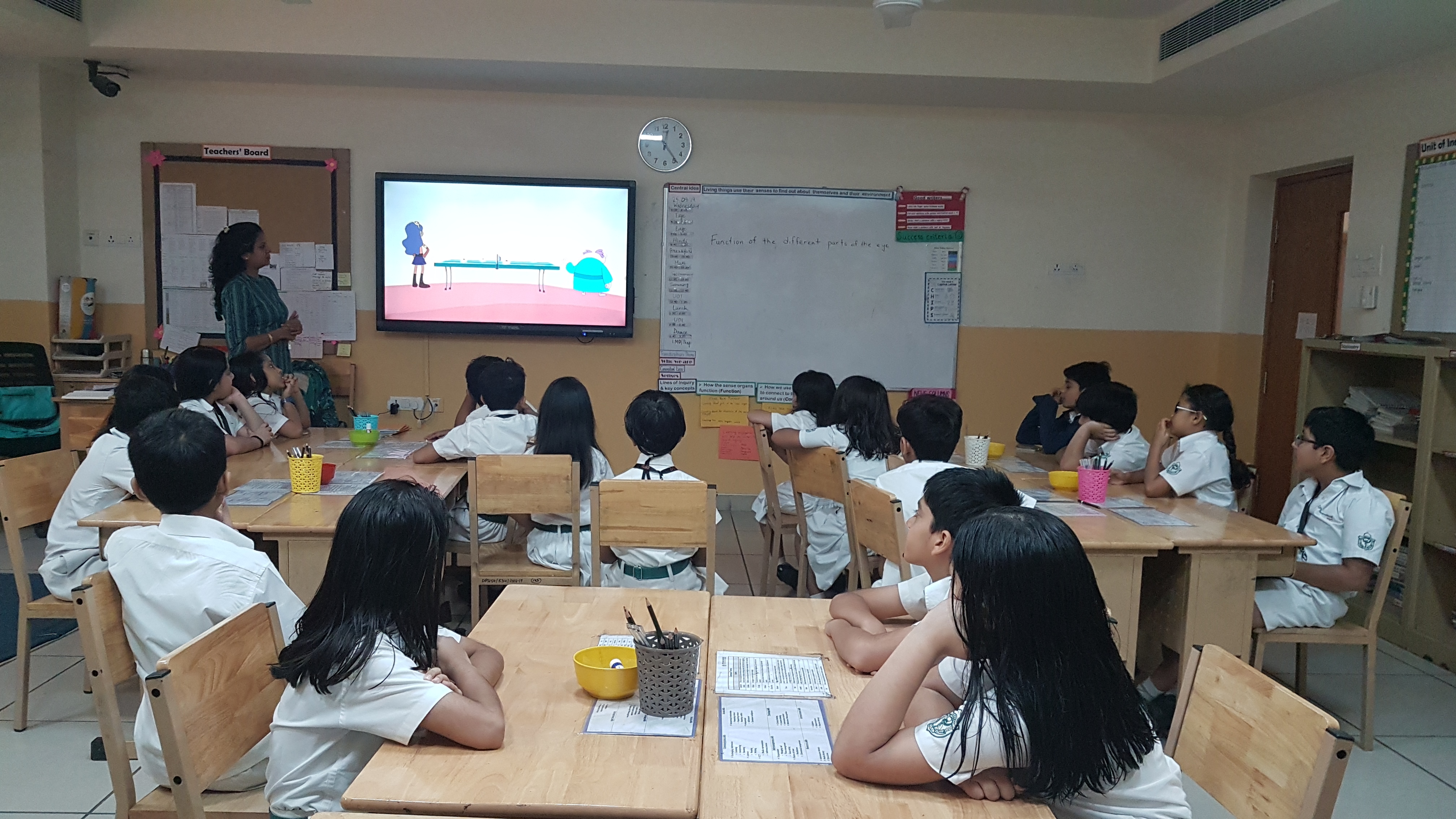
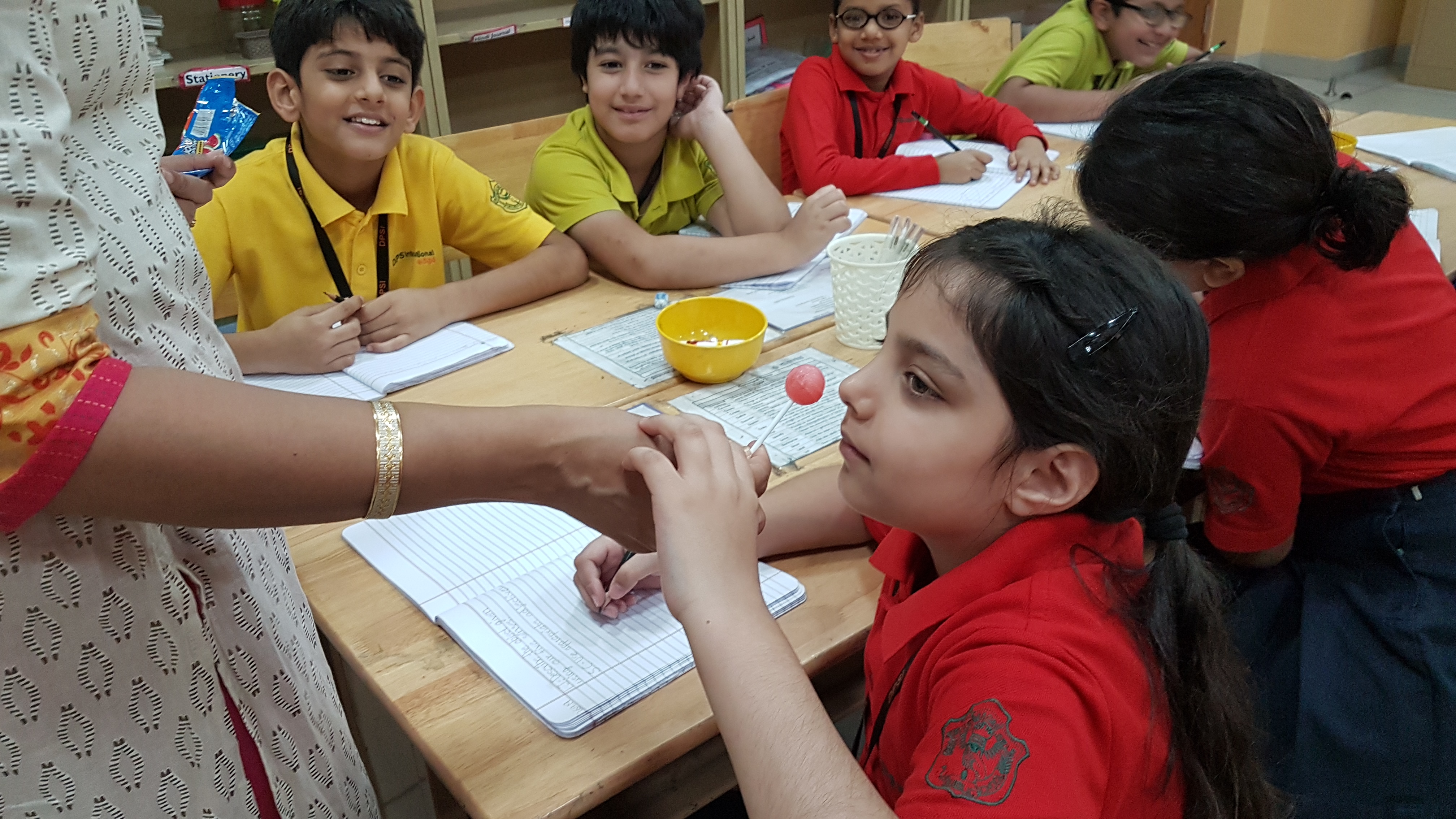


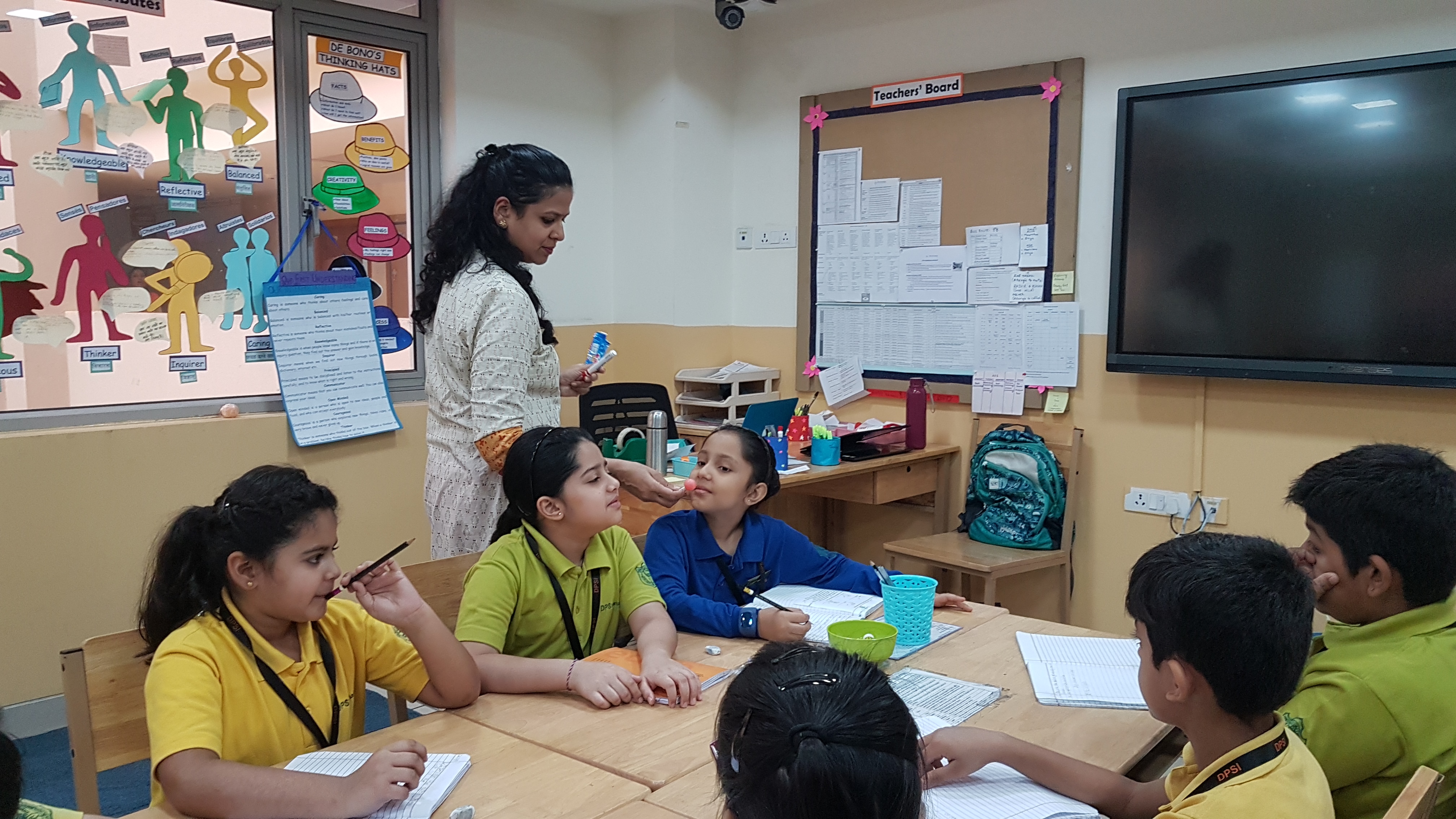



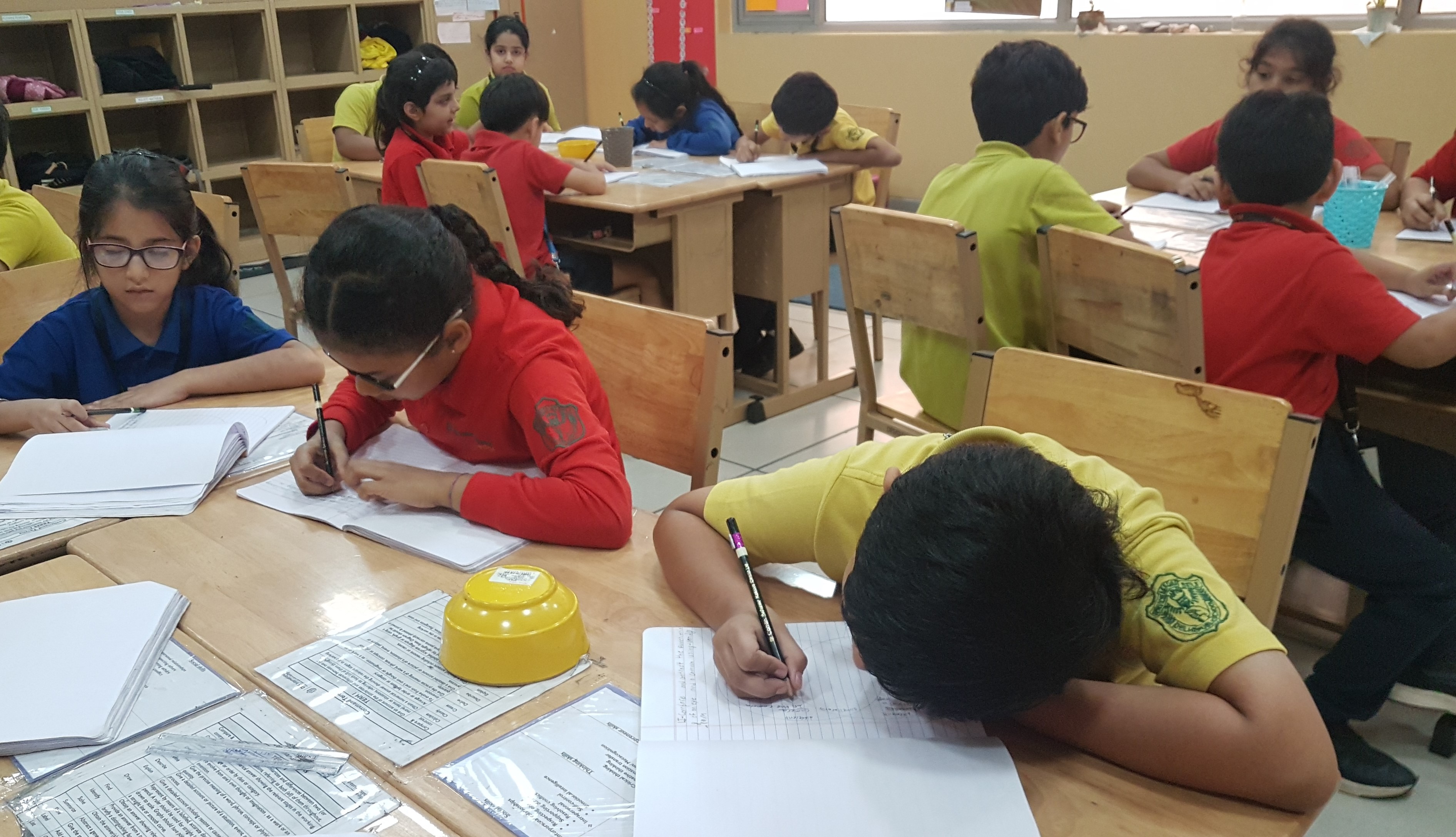
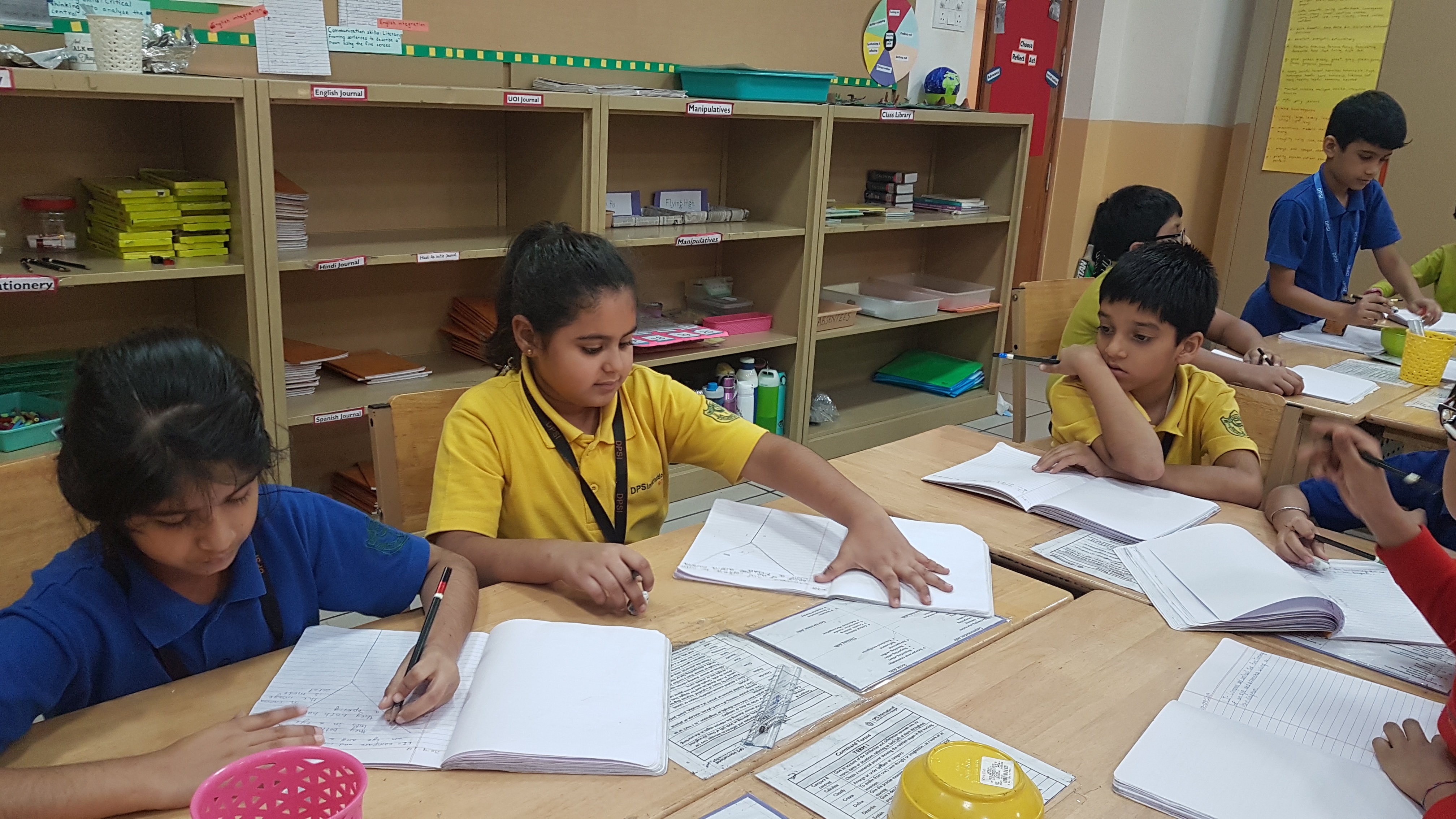
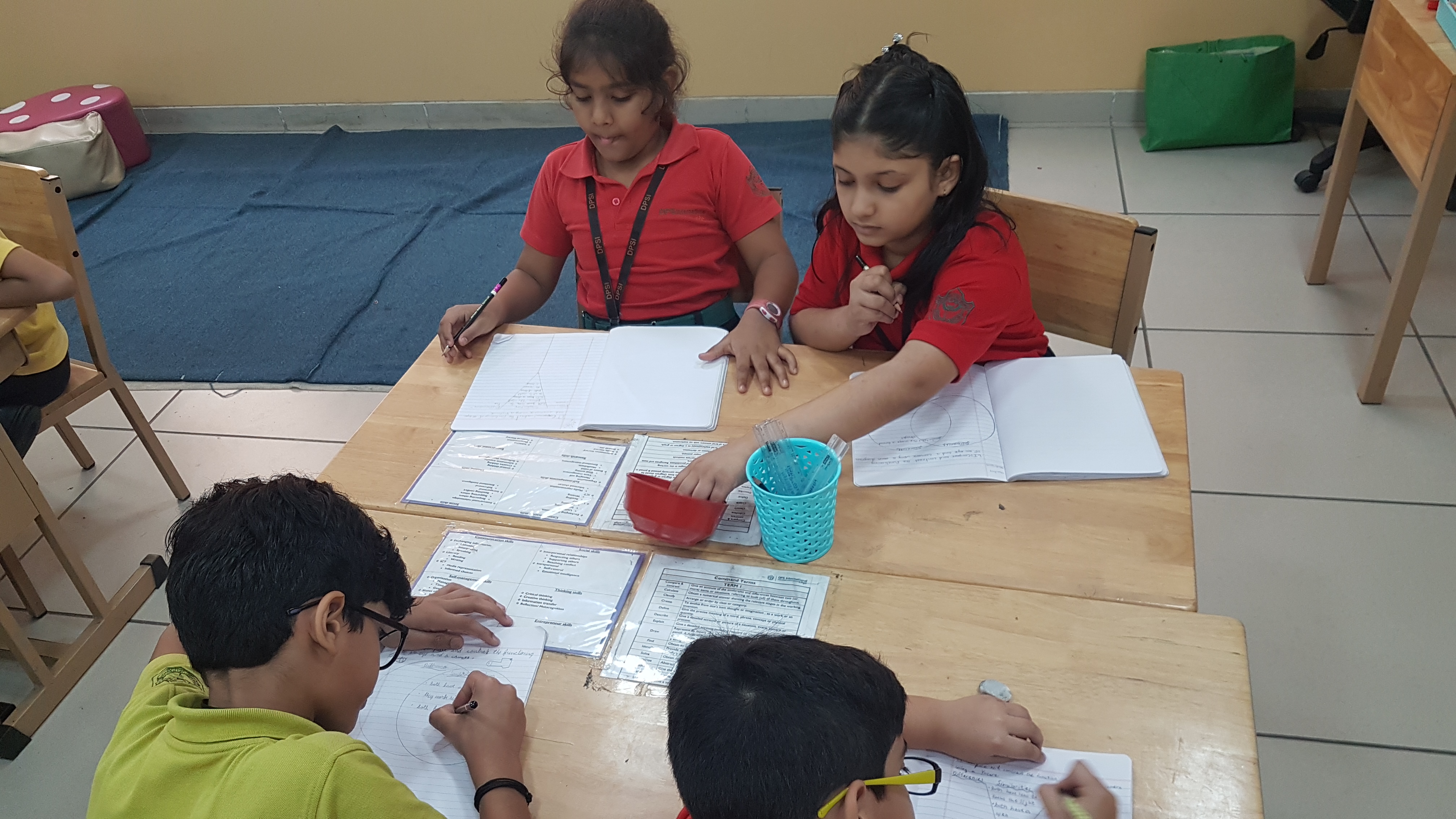
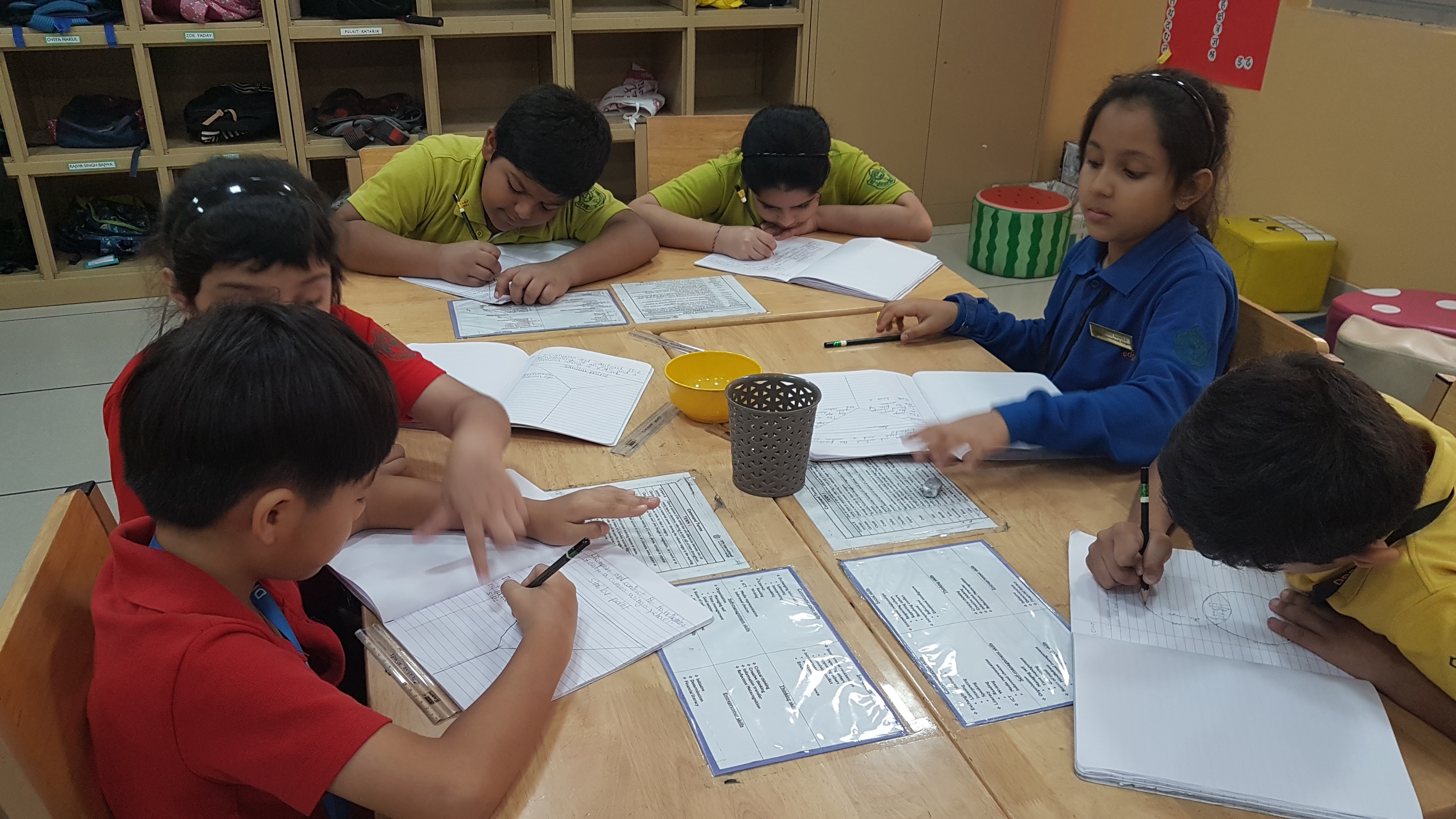
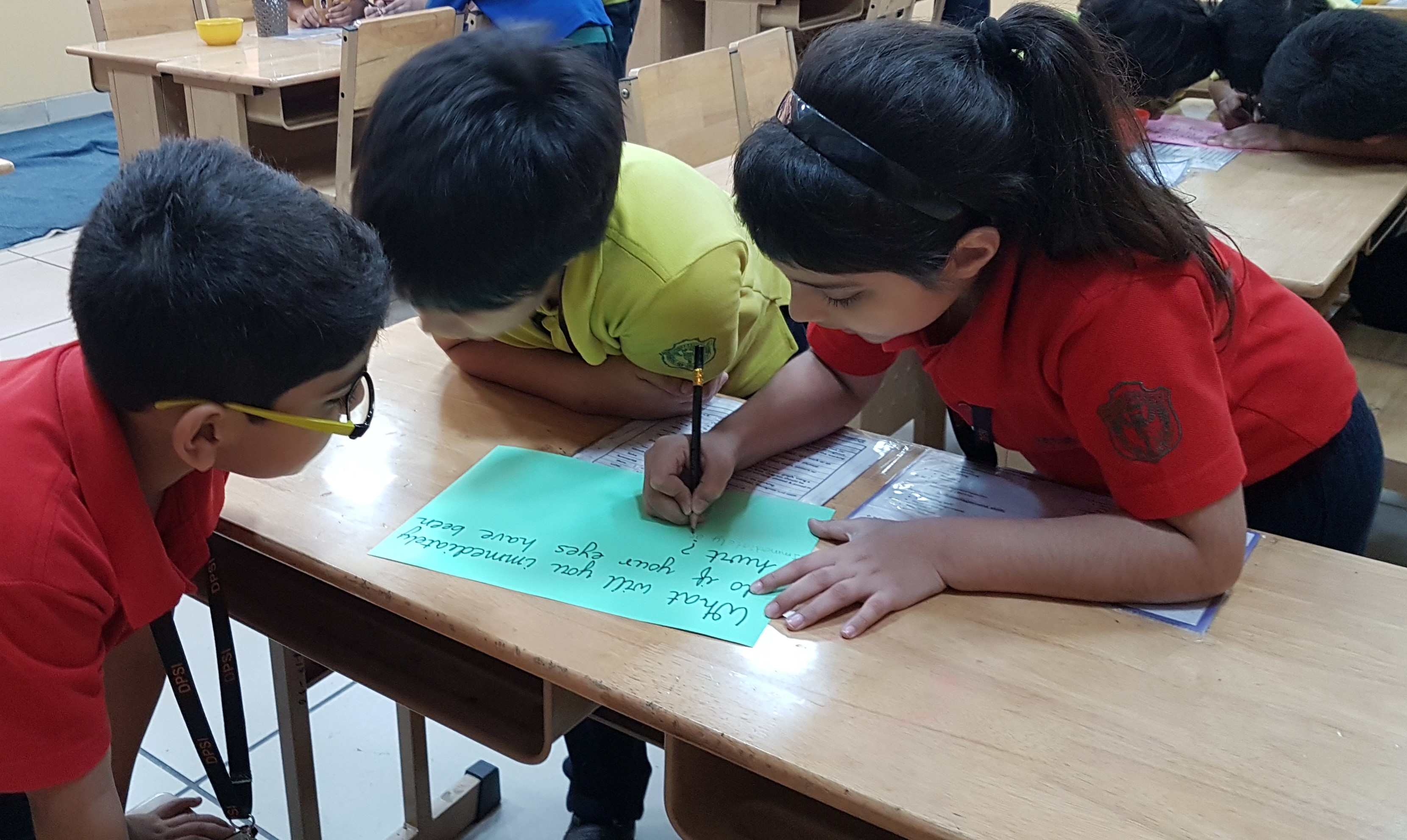

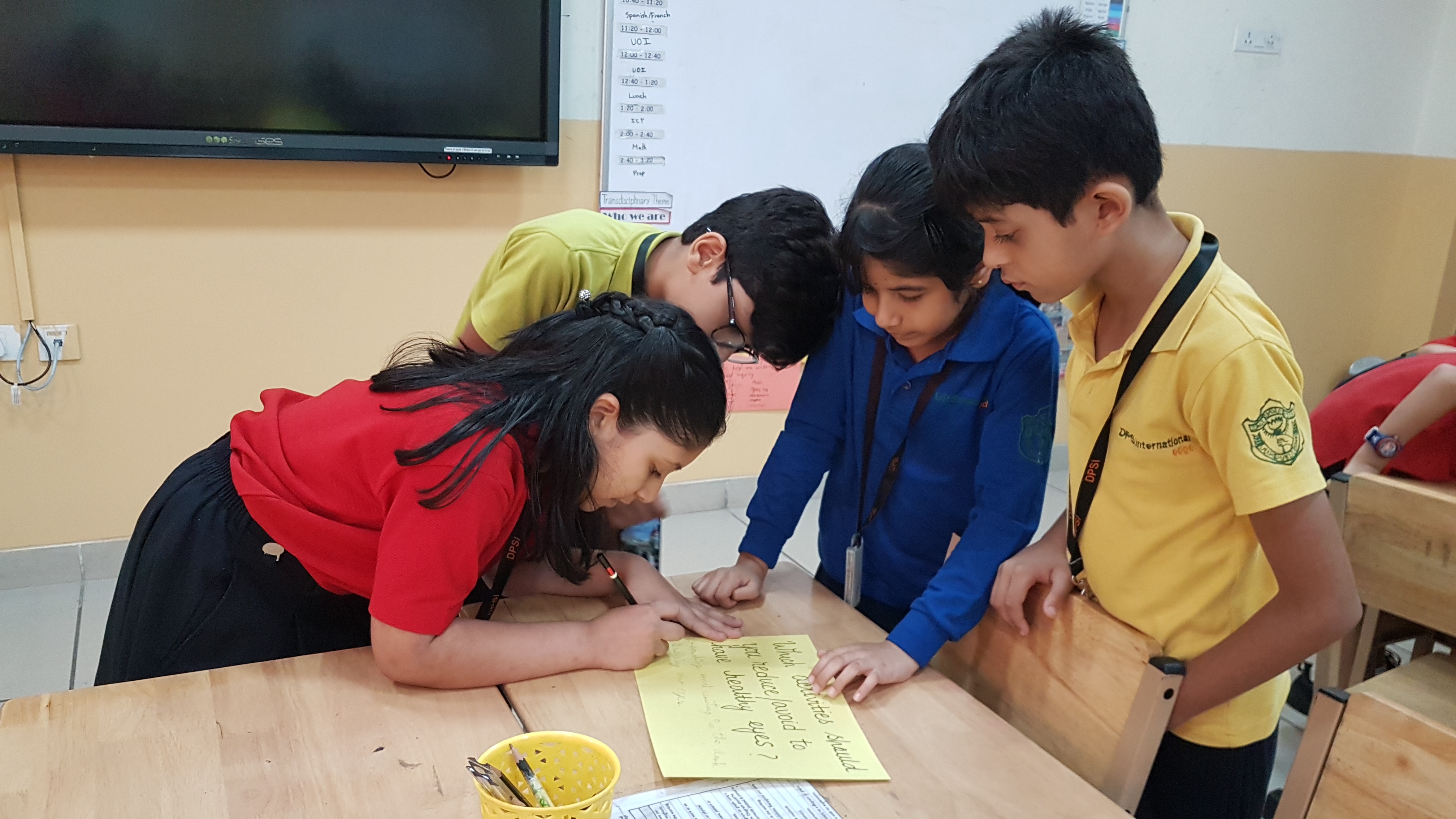
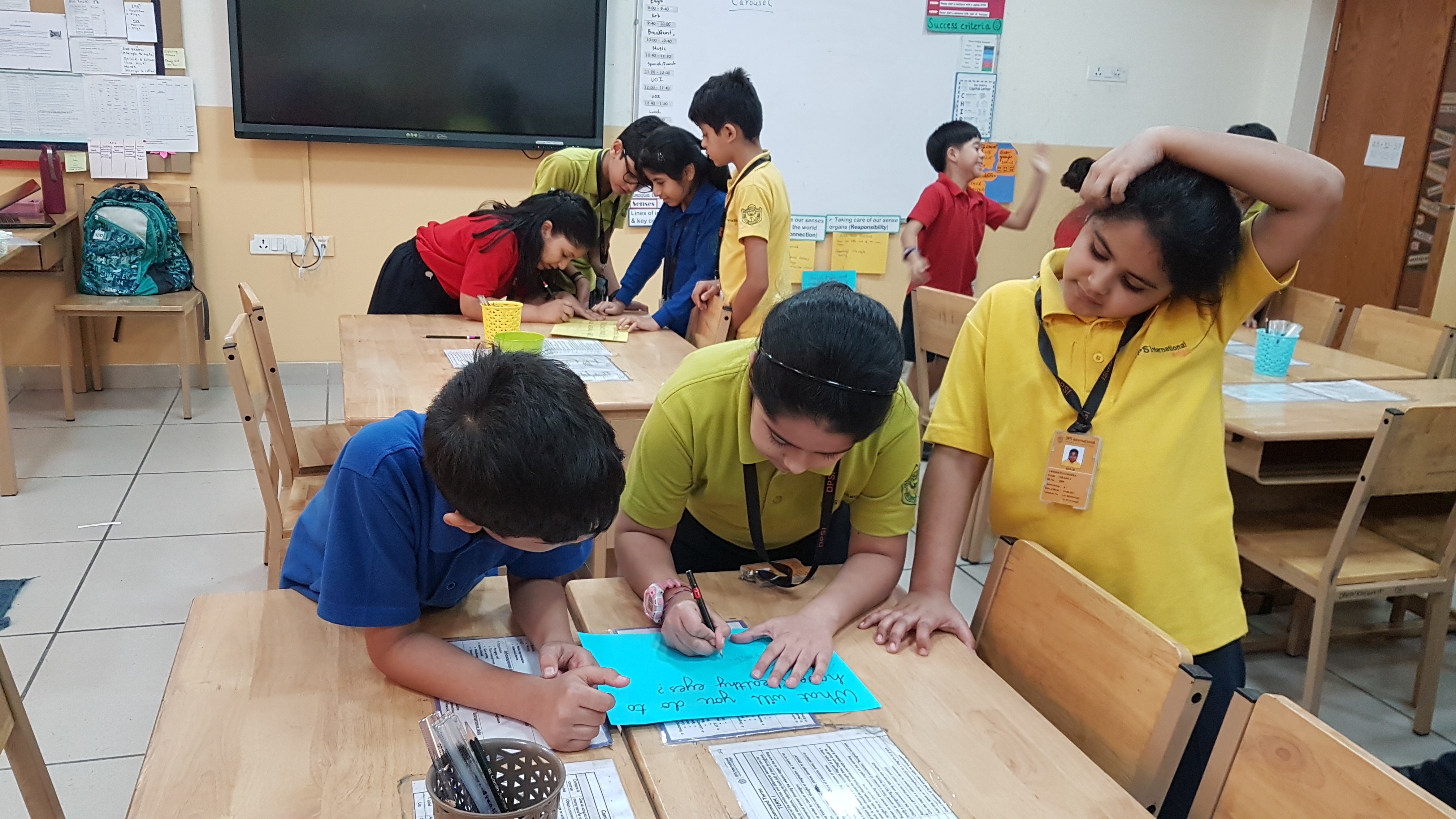
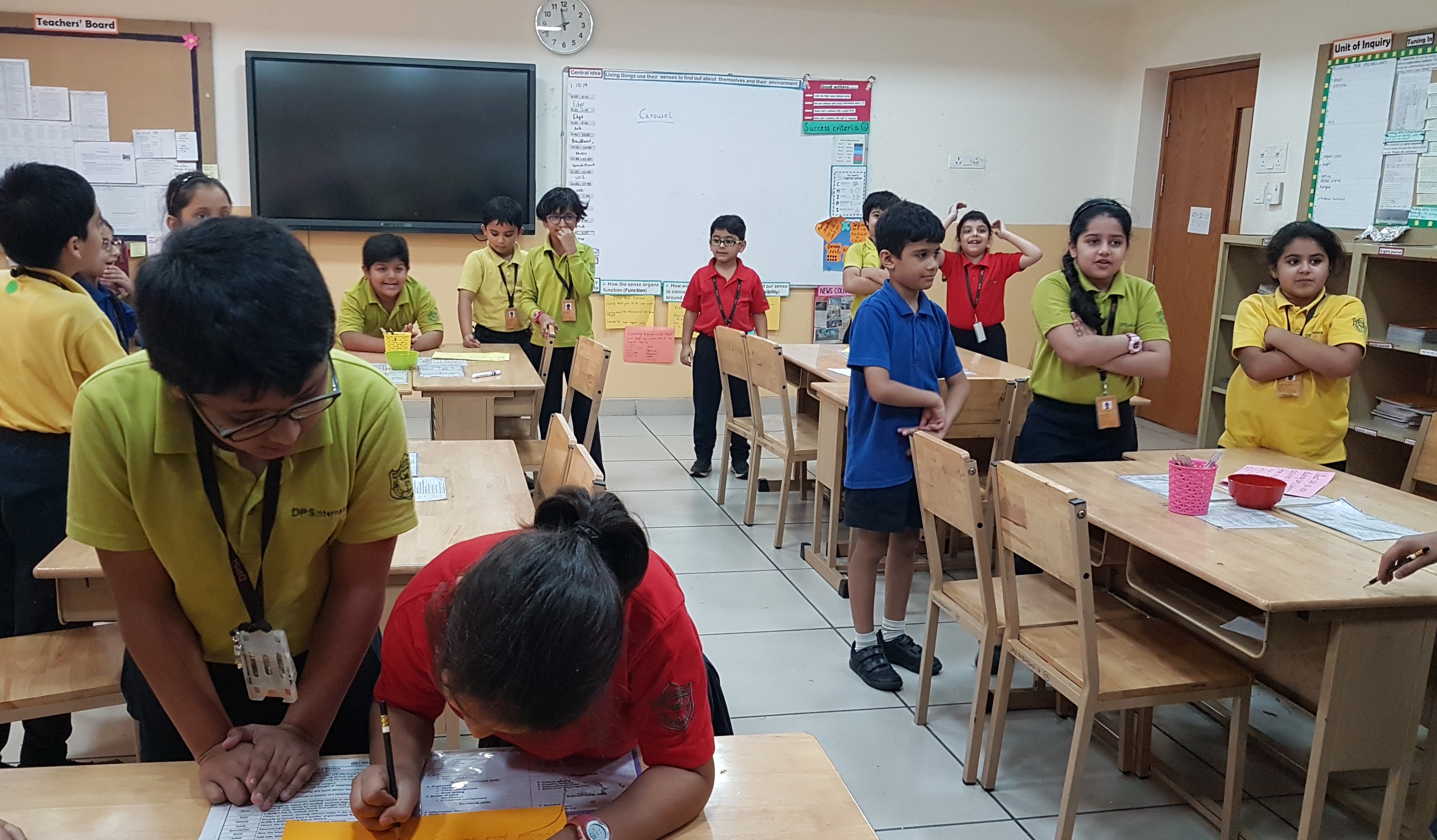
English
Integrating with the current unit, the students watched an interesting video on the sense of sight and after a peer discussion they collated facts about it in their journals. They explored certain items with reference to their senses and described them in their own words.
The class read the second chapter of the novel ‘The Eyes of the Eagle’ and identified ‘flat characters’ and ‘round characters’ and their impact on the story. They then went on to describe the same in their journals.
They read a comprehension passage and answered questions on how to take care of the eyes.
Pronouns were introduced through a parody song. The students furthered their understanding by framing sentences using common/proper nouns and changing nouns into appropriate pronouns.
The students also used a medium of their choice such as posters, visible thinking routines and comic strips to summarize the second chapter of their novel study.





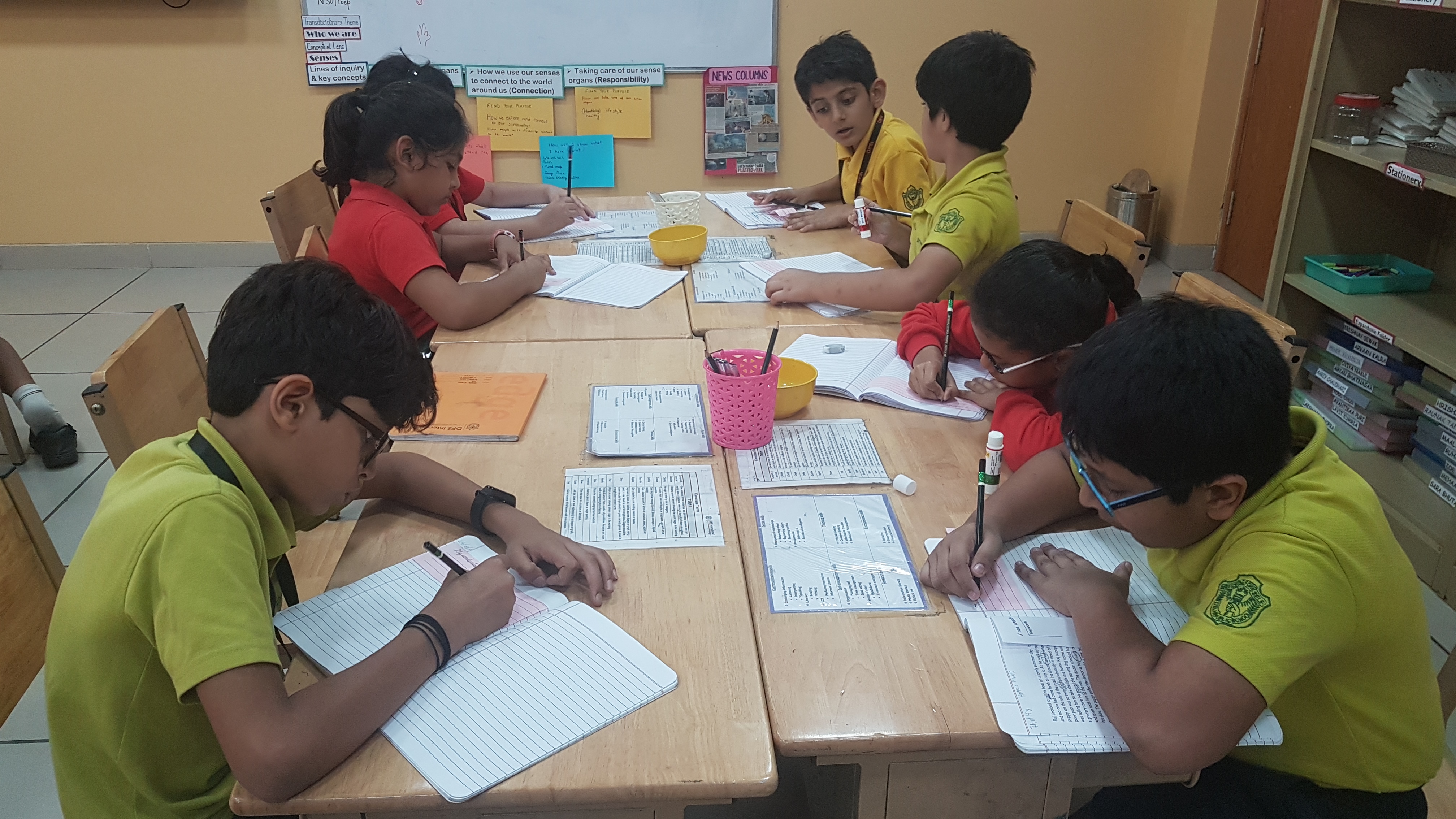



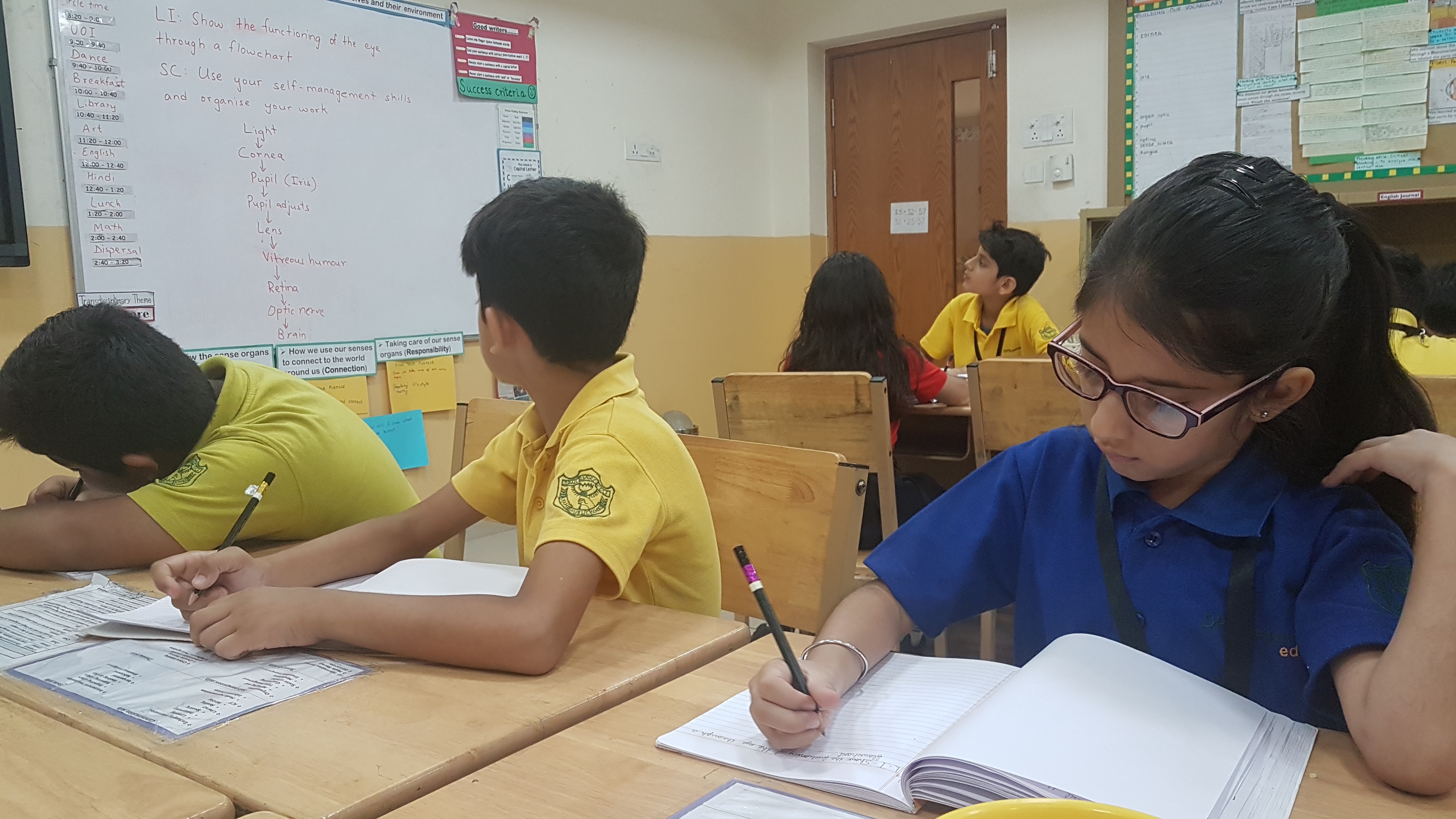



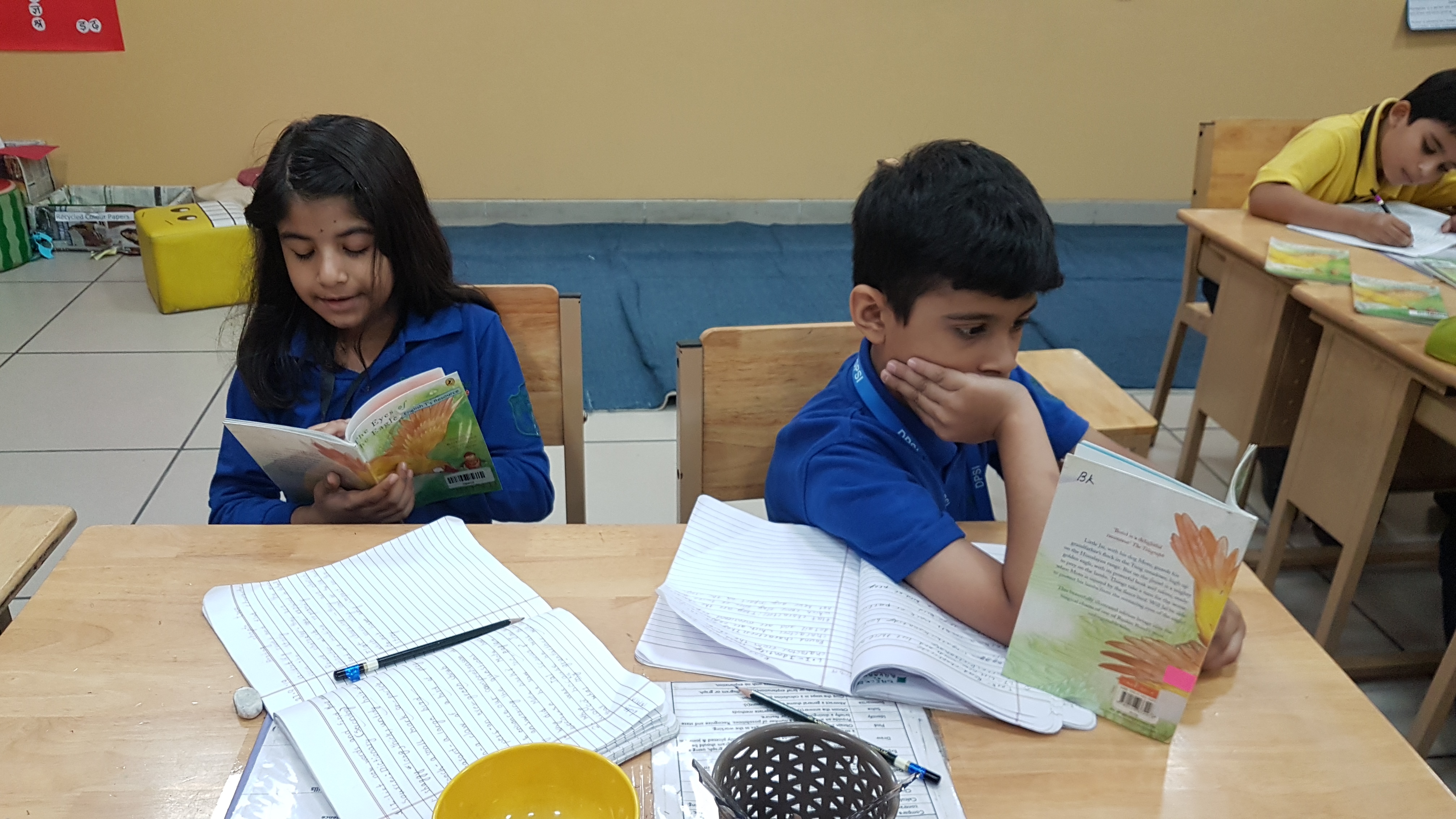
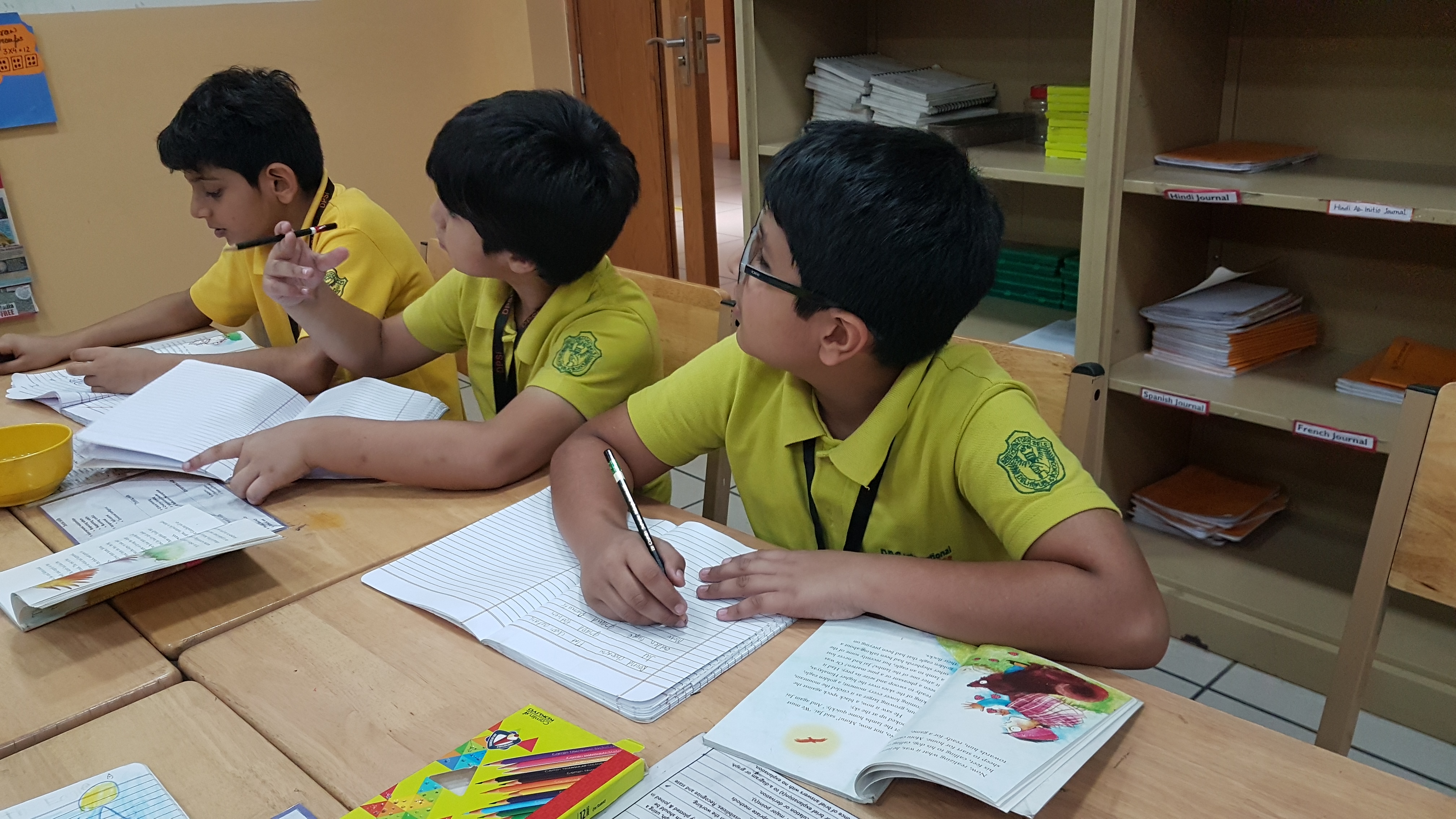
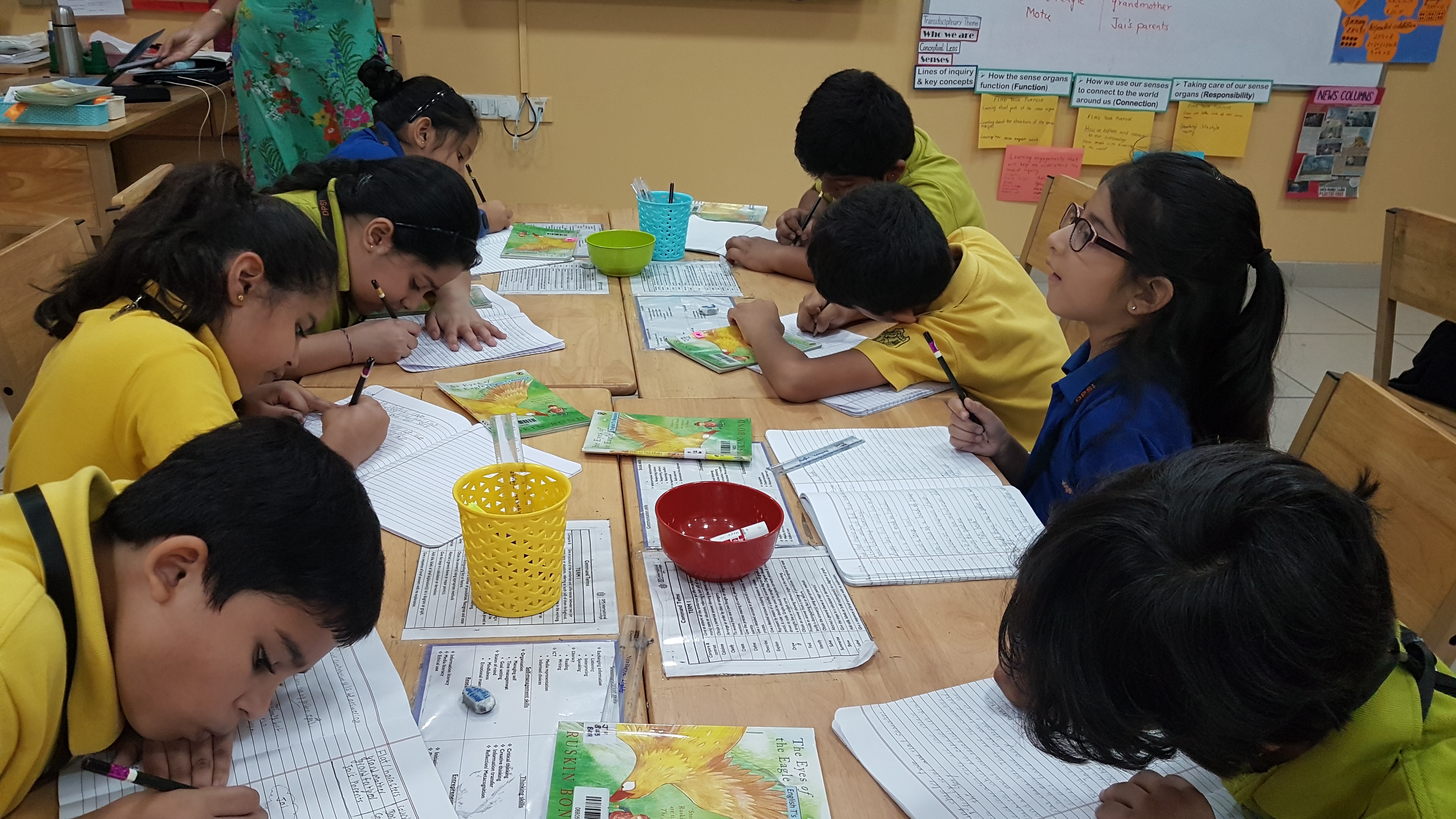
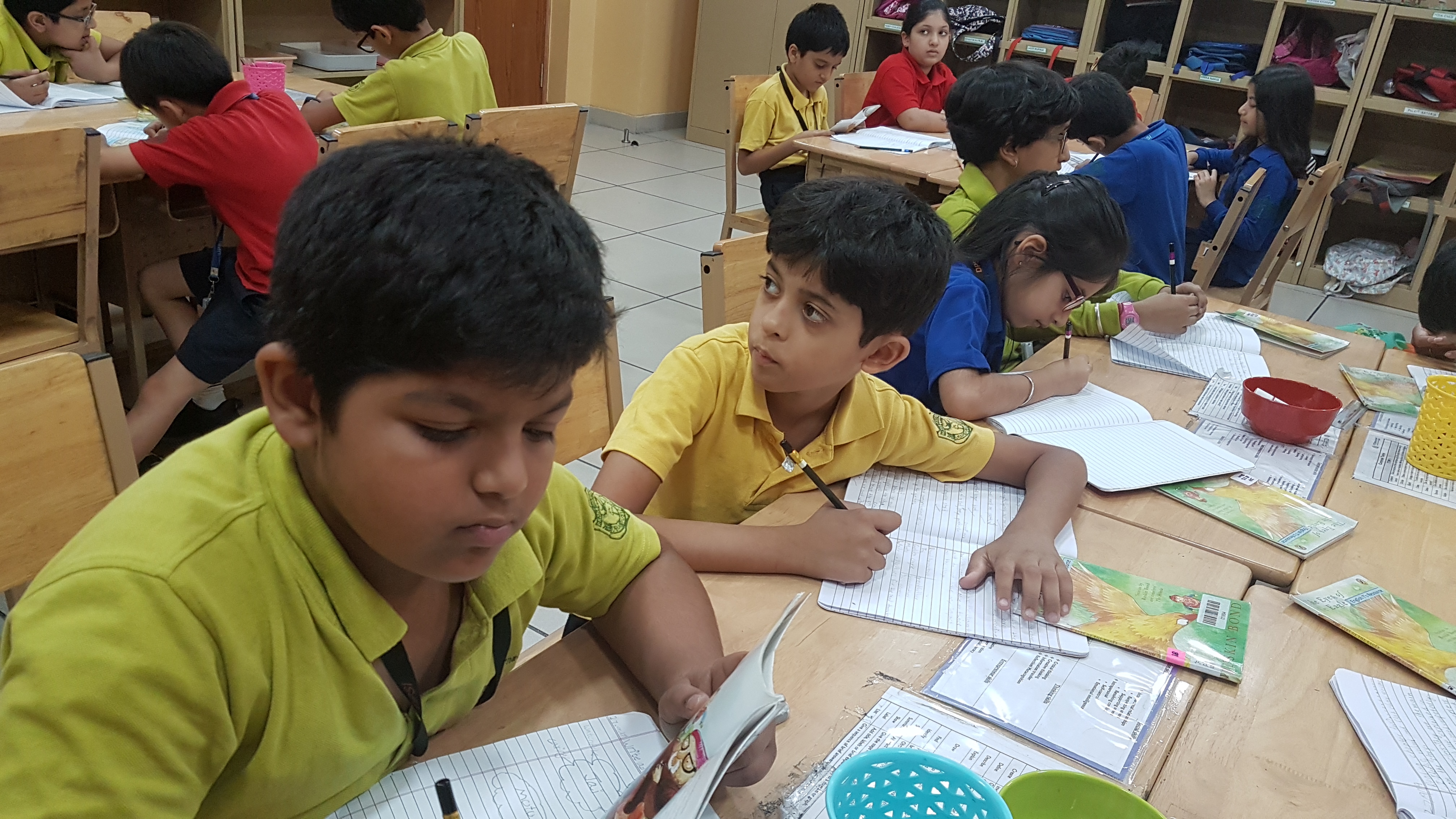


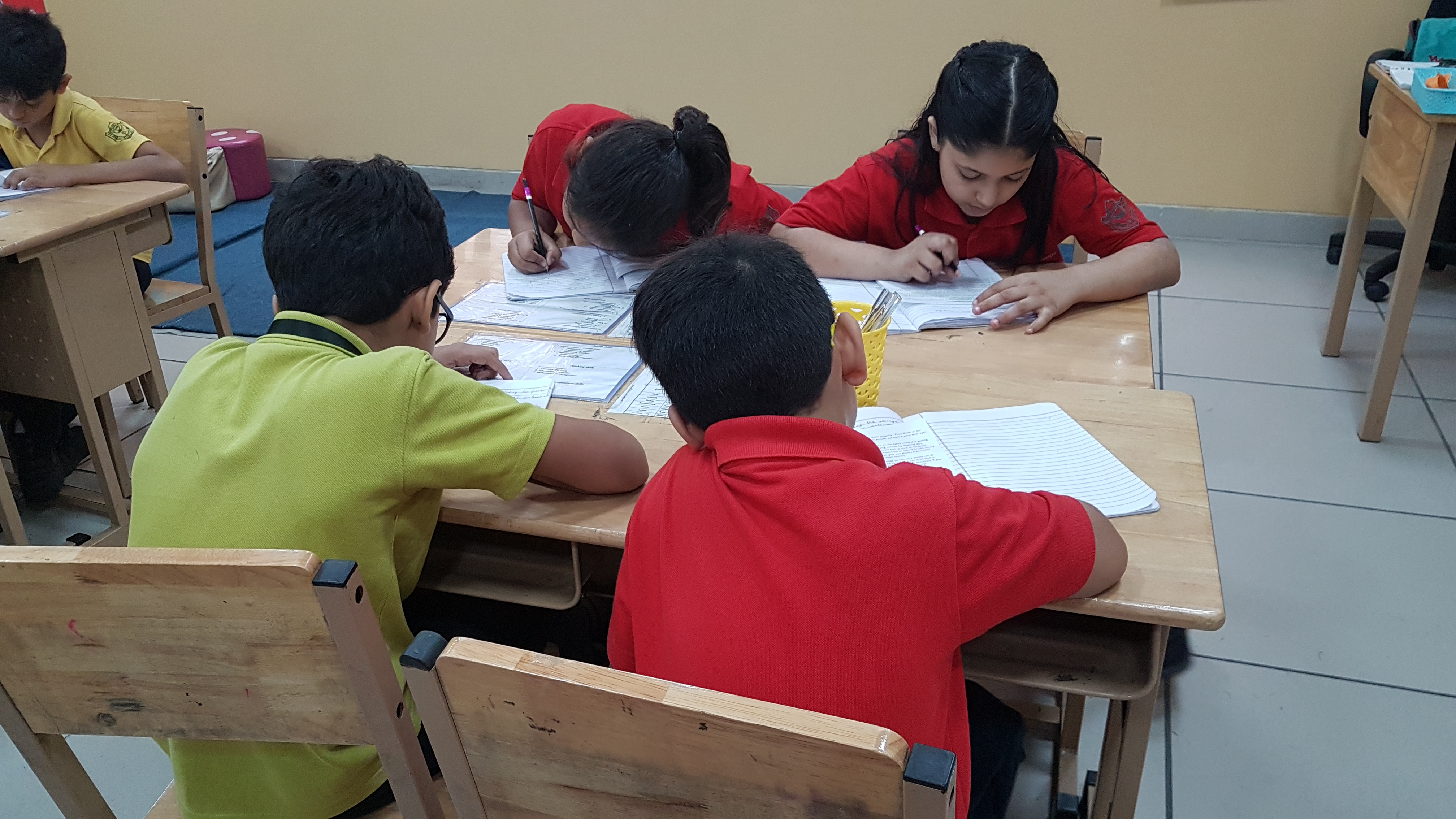
Mathematics
The students were tuned into multiplication with a story of the ‘one hundred hungry ants”. Through a card activity they identified ‘arrays’ and the number of items in each row. They reflected on their understanding by a visible thinking routine – CONNECT EXTEND CHALLENGE. They furthered their comprehension of the terms ‘factors and products’ and practiced time tables for 2,3,4,5.
The students were put into pairs and played with UNO cards to practice multiplication. They were introduced to the four properties of multiplication -commutative, associative, multiplicative identity and distributive.
They then progressed on to learn multiplication of 2-3 digit numbers and practiced the same in their journals.
Multiplication Math Ping Pong – Commutative Property
Multiplication Associative Property


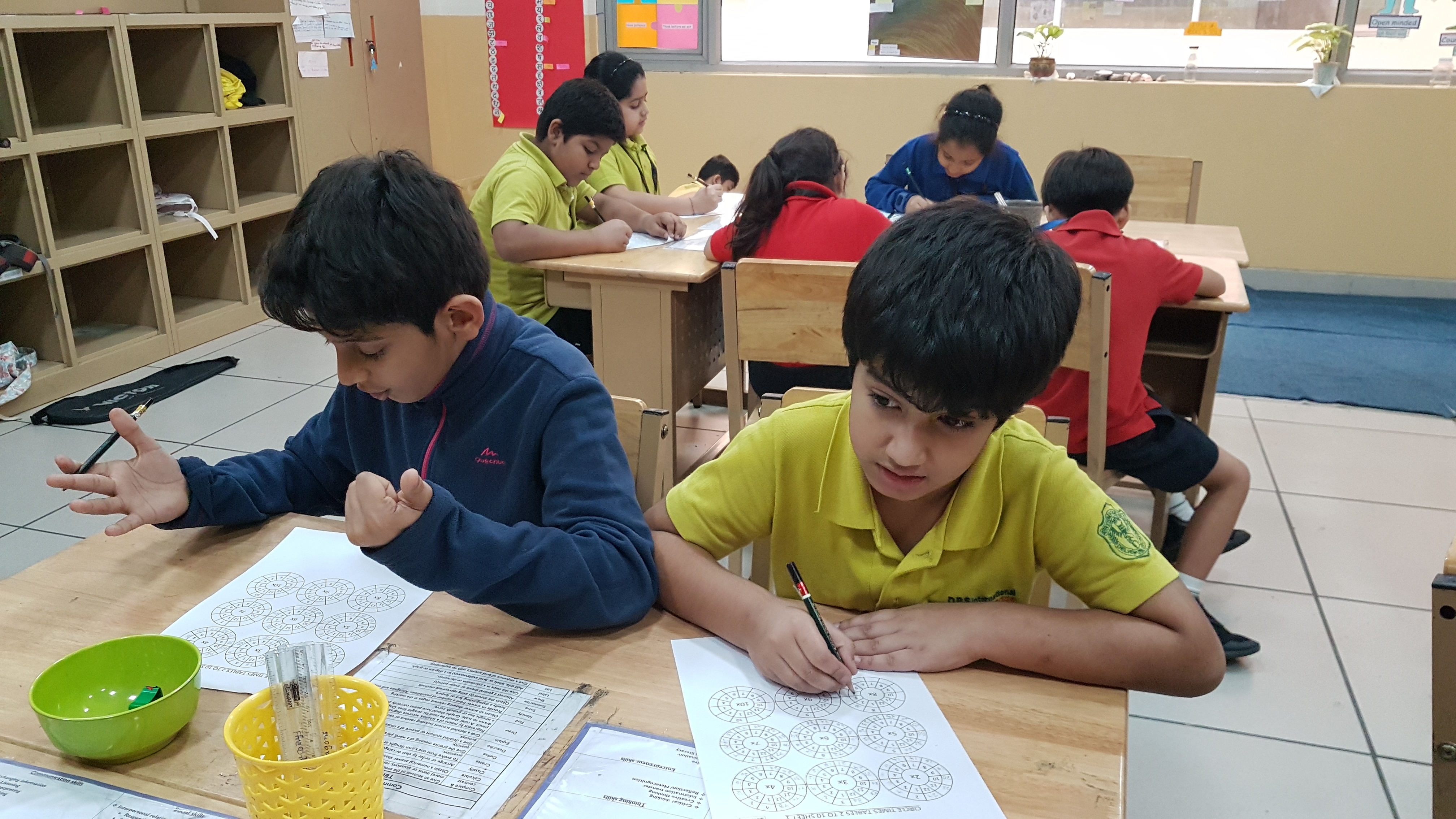



Hindi
In order to enhance their critical thinking skills and speaking skills, students discussed and wrote a passage after watching the documentary जलवायु परिवर्तन : फैसले का समय (Jalvaayu parivartan) . Students used a graphic organizer for sorting causes of environmental pollution, reasons, effects and suggestions. Their knowledge of spellings was peer assessed using a spell bee activity.
Hindi ab-initio
To enhance their listening skills in Hindi the students listened to a story named ‘Tota’ and watched the Hindi stories ‘ Sher ki khaal mei gadha ’ and ‘Boltee gufaa’.
They cut and pasted pictures of animals and birds through a ‘Jungle Activity’.


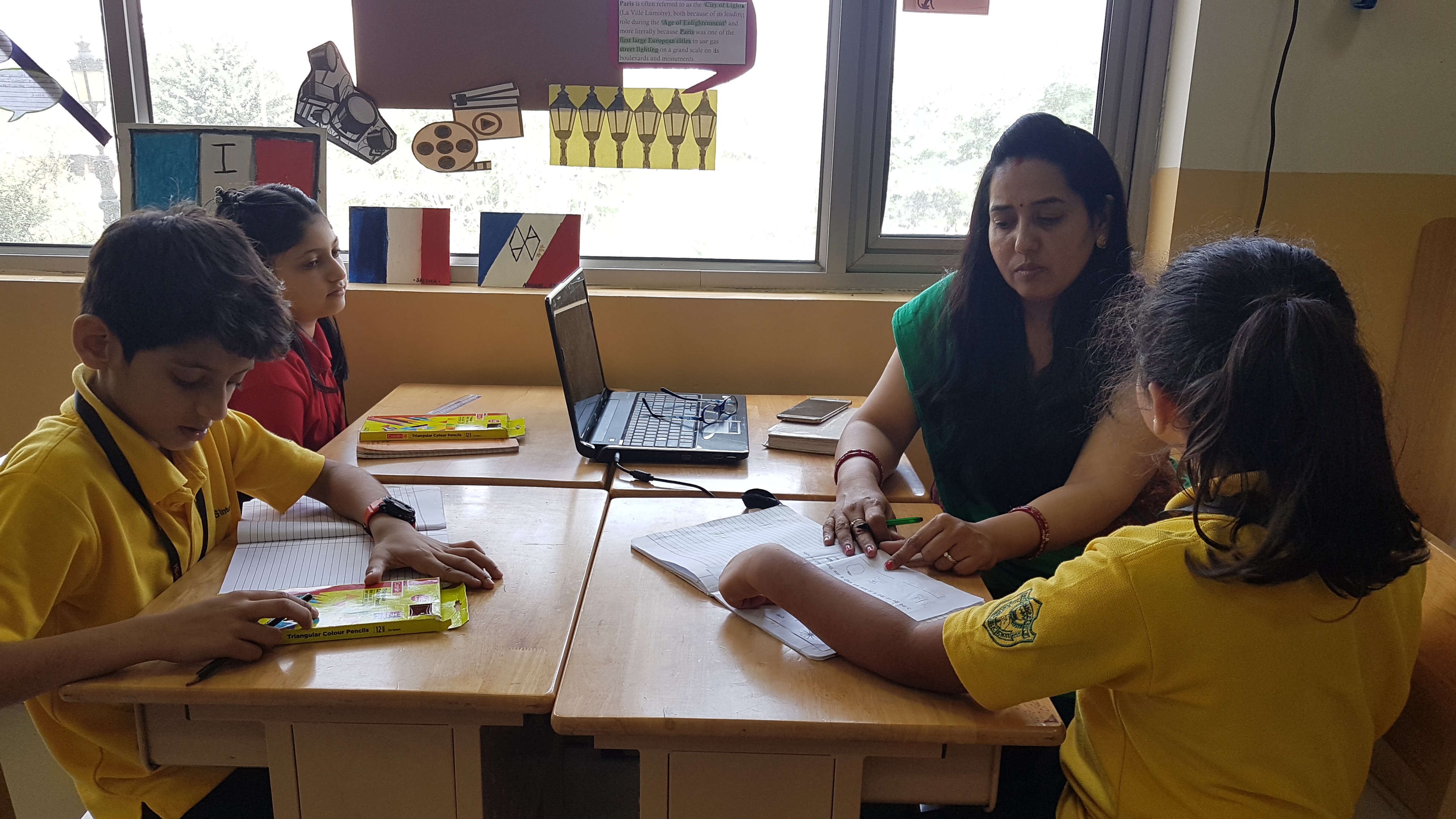
French
The objective of the French lesson allowed students to recapitulate their grammar and vocabulary and self-assess their homework to encourage learner involvement and participation. Thoughtful discussions helped them to correct their own work under the supervision of a facilitator.
Spanish
Students were taught to introduce themselves in Spanish. They learned to start and end the introduction with greetings that they had practiced in class. They also made posters representing themselves and revealing their likes, dislikes and favorite things which made them communicate effectively. Through role play in class the students conversed with each other to improve their pronunciation and listening skills.
Library
Students celebrated the birthday of the English author, poet and playwright Michel Morpurgo who is best known for his children’s novels; the most famous of them being the ‘War Horse’. He became the third Children’s Laureate, from 2003 to 2005.
The class discovered more about the author’s books through a poster prepared by the library and read additional literature from the Michael Morpurgo book shelf at school.
Swimming
Students continued to practice breast stroke leg action. General fitness routines and sports edge lessons continued.
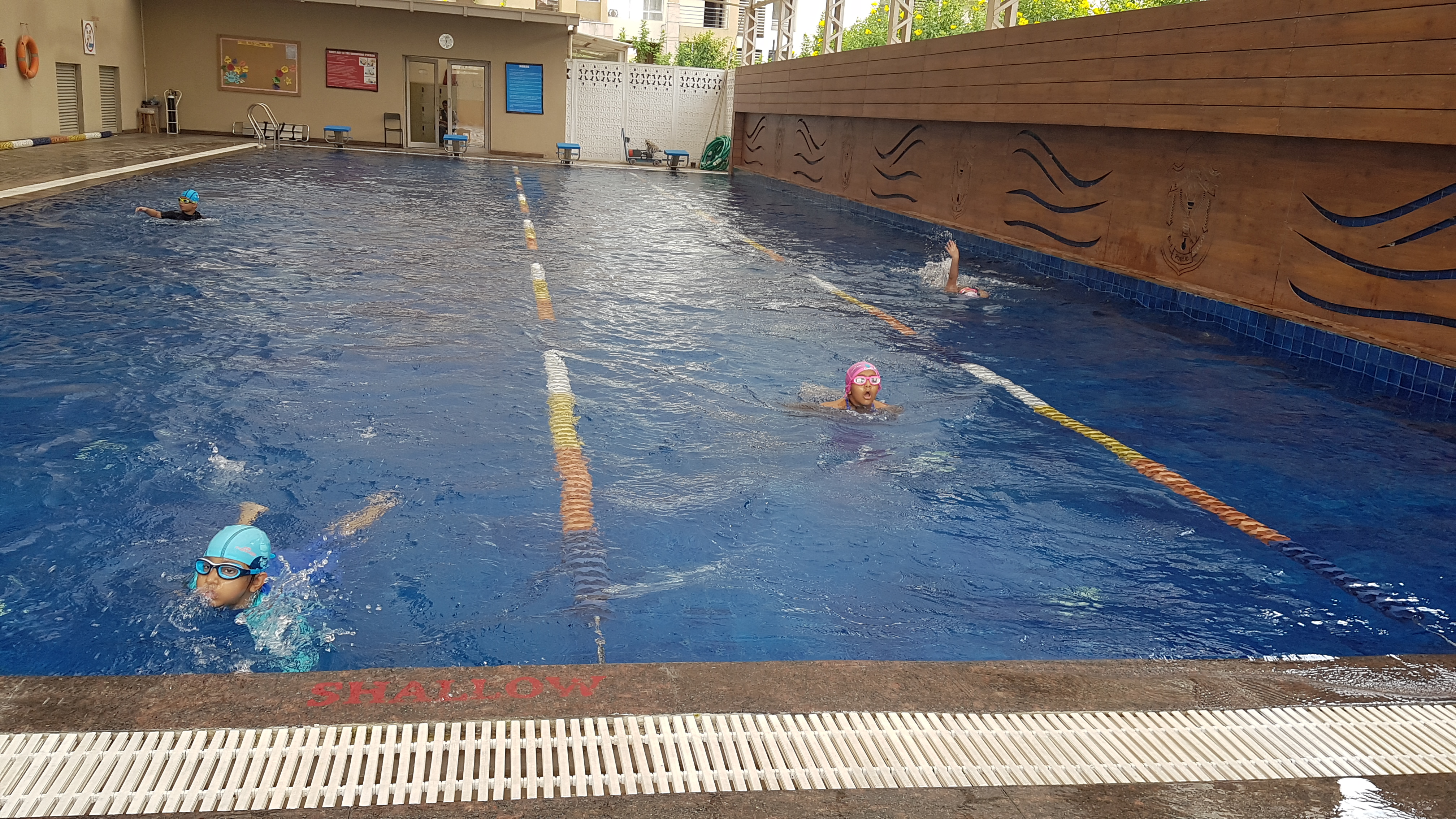
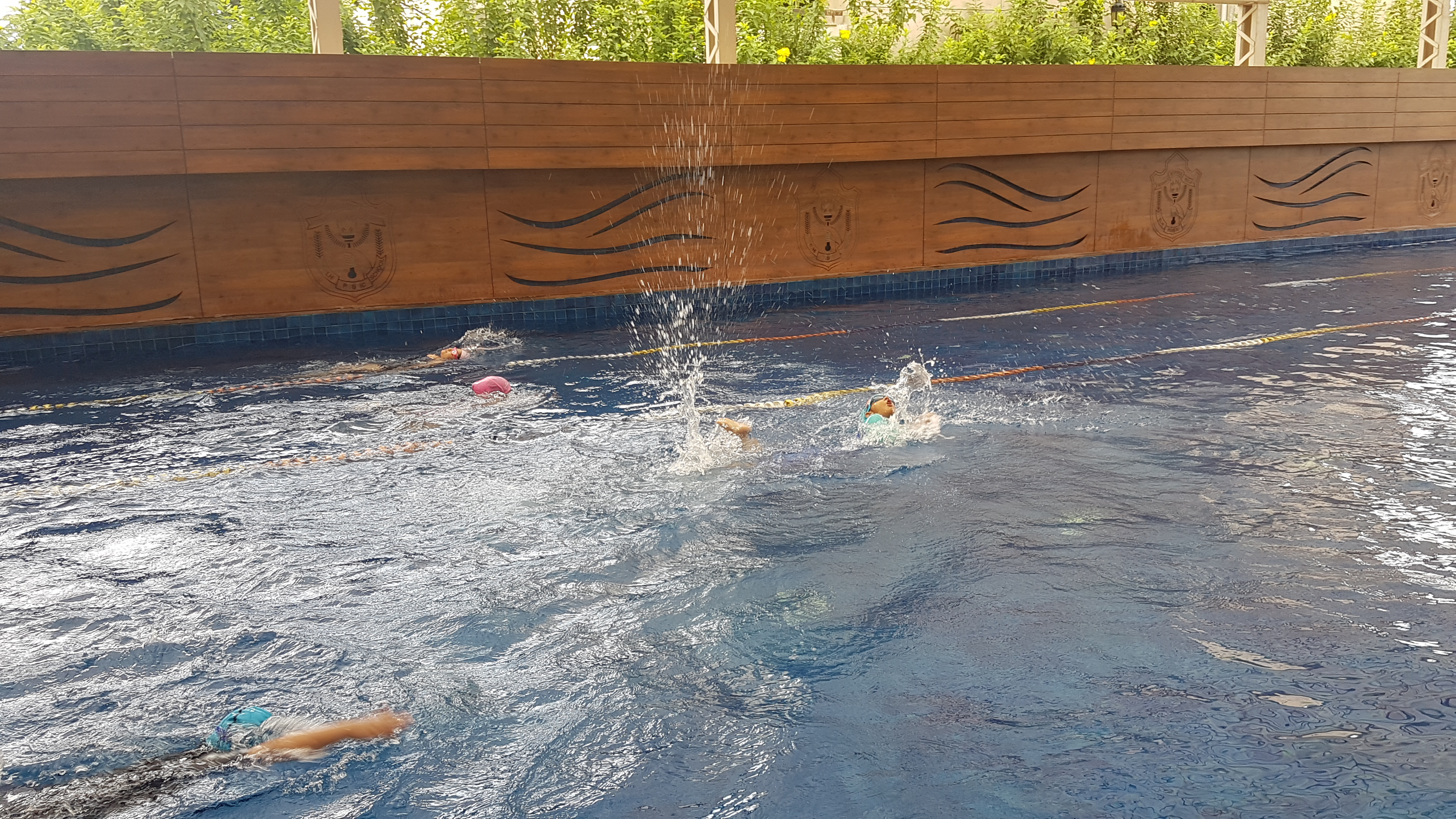

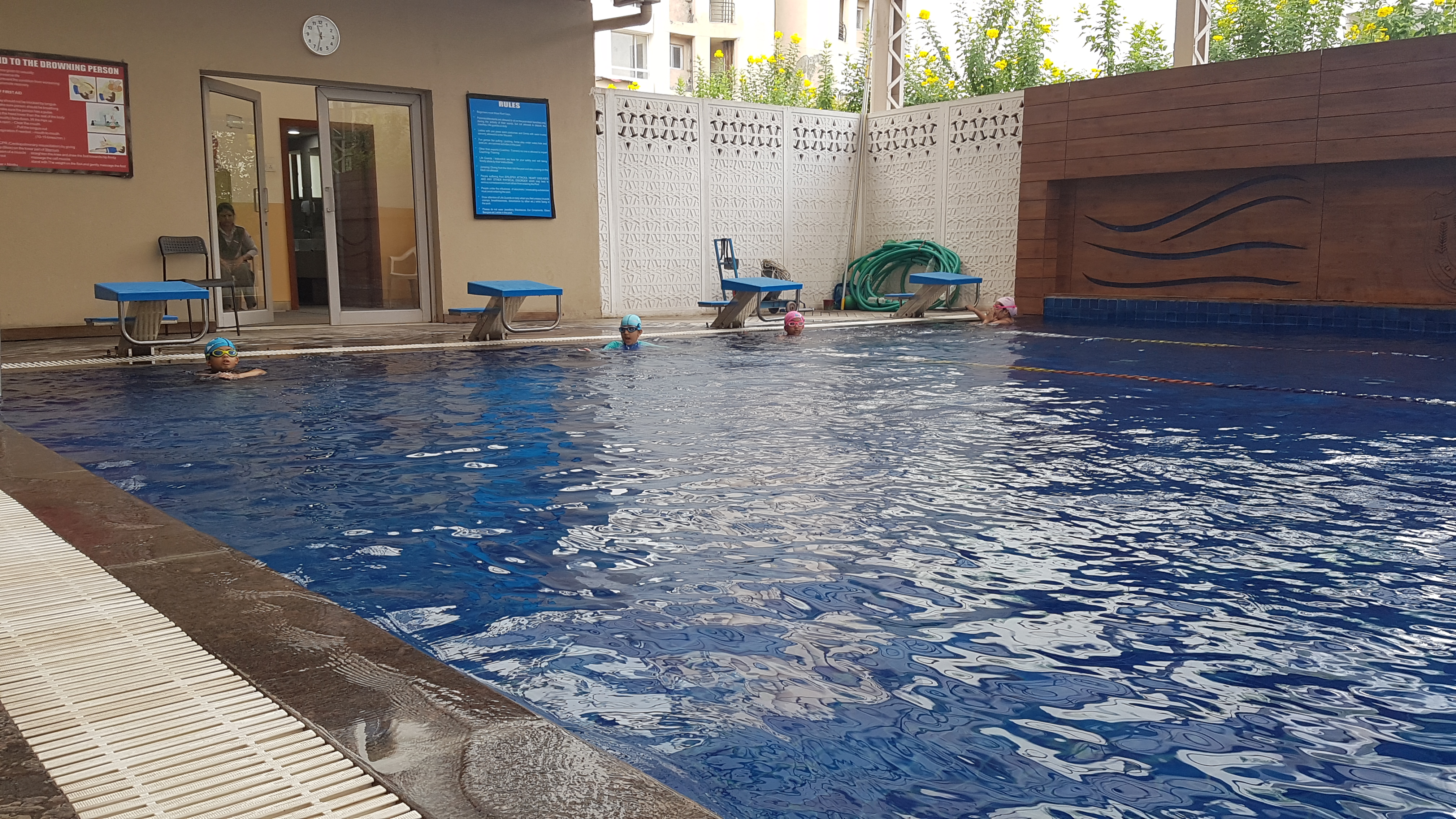
Art
Students completed their contemporary art compositions and were able to write down their reflections based on the strengths and weaknesses of their artwork. They also demonstrated how they incorporated student agency during the process.

Dance
Dance lessons focused on the evolution and emergence of various dance forms. Students were challenged to stretch their bodies for better flexibility. Warm ups and exercises were done to increase suppleness while jumping, spotting, kicks and plies were executed to improve posture.
Music
Students revised their work on the evolution of musical instruments (string family) while referring to the unit based on the central idea. They were also introduced to the evolving genres of music .
The class will soon be assessed on their knowledge of the topics covered so far which are as follows: Note, note values, identity notes and evolution in music as well as the song “You’ve got a Friend in me”.

ICT
Students constructed a 3D model of a human eye while using the magic select tool and 3D doodle tool in Paint 3D. They labelled different parts of the human eye using 3D text. They also learned how to save the 3D model as a 3D object in FXB format. Within paint 3D, students used the online 3D library to browse and access 3D models for use in their creations.




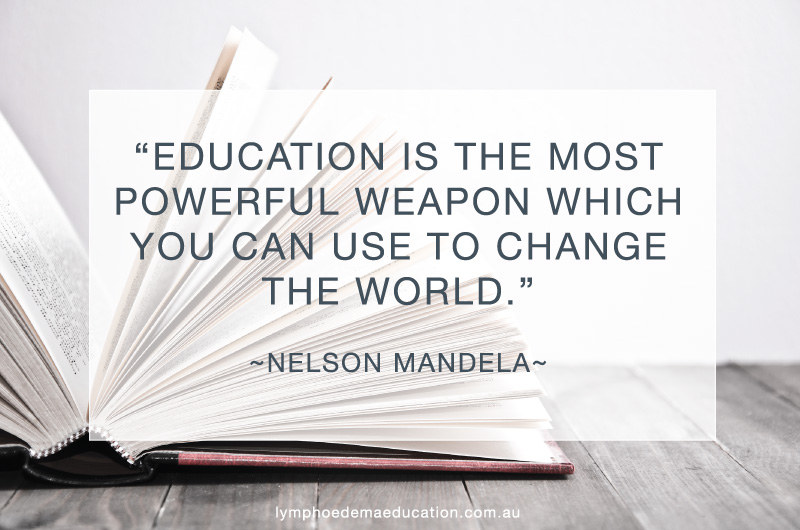
September 20, 2019
When you know better you do better.
Maya Angelou
Students at school enjoy taking part in various initiatives rooted in the firm belief that every individual action can make a difference. The Eco club is a hands on project that involves each child in the task of caring for the environment. While reinforcing sustainability this drive has gone one step further by placing cartons in the school corridors for recycled paper, newspapers and even upcycled clothes that are put to good use later.
Regular Hindi lessons encourage students to converse with each other; keeping ten minutes for speaking only in the vernacular language brings joy and builds interest. Being fluent in a language requires motivation and appreciation for the effort to draw on vocabulary that shuns the use of words that do not belong to the one being spoken….. difficult but not impossible!
Unit of Inquiry
The week began with an interesting discussion on natural and manmade disasters. By employing the ‘double bubble’ map and T-chart, students compared the two and explored different ways on how humans are responsible for global warming. A discussion with Ms. Sutanuka Bhattacharjee on the recent fires in the Amazon was an initiative in this direction. The class deliberated on the session by applying a visible thinking strategy ‘connect extend challenge’ and keenly observed different experiments on soil erosion, weathering, deposition and loss of wetlands. They then demonstrated their understanding of the topic using the ICT tool ‘Flip grid’ and summed up their learning by using the fishbone strategy.
The students then geared up for the provocation of the new unit by using the ‘I see I think I wonder’ visual thinking routine by exploring different stations with items related to senses. They used their thinking skills to write what they thought about the new unit and exchanged information to identify key words to understand the central idea.
Natural and man made disasters Natural disaster Man made disaster









English
In order to integrate with the current unit, students studied a few pictures using the visible thinking routine ‘Explanation game’. They were introduced to the concept of a thank you note and its importance and then framed the same for planet Earth. They also revisited the concept of articles and their usage by framing meaningful sentences. The class prepared and presented a ‘take and talk’ on landforms as well.
Students read the first chapter of the novel “The Eyes of the Eagle’ and identified unfamiliar words from the chapter. They used a dictionary to find the definition of those terms and noted them in their journals.












Mathematics
The new week began with students revisiting different properties of addition and mental math strategies. They were keen to learn the concept of doubling through a ‘think, puzzle and explore’ strategy. The CUBES strategy was discussed in pairs which was followed by creating and assessing each other’s word problems. By using the ‘Traffic light’ visual thinking routine students reflected on their understanding of the properties of addition, doubling, mental math and word problems. They were also introduced to the compensation approach for addition and word problems.





Hindi
In their Hindi lessons, students watched news segments on water pollution, ’तेरा कचरा तुझको अर्पण’ and attempted a ‘Listen and Tell’ activity. They celebrated ‘Hindi Diwas’ based on the theme ‘Sustainability’ where students initiated a movement to save paper and will take the initiative to audit wastage and recycling throughout the year. They also read the story ‘मिनामाटा की कथा’ (Minamata kee Katha) and enhanced their reading skills. Later, a ‘Chalk and Talk’ activity was performed where questions were framed and discussed with classmates.
Hindi ab-initio
To enhance their writing skills the students wrote bina maatraa wale shabd. They also watched the Hindi stories ‘Chatur khargosh aur sher’ and ‘Jaaduee pencil’. They also heard the Hindi story ‘Kudatee zuraaben’. They celebrated Hindi Diwas by creating posters to create awareness about how everyone can save paper.





French
Using the ‘LINK strategy’, learners first made notes of what they already knew about France. They delved deeper into the country’s history and shared their knowledge through a group discourse.
They were able to discover basic facts about France through the use of manipulatives and the internet and created a graphic organizer of their choice. They developed their thinking skills (acquisition of knowledge), self-management skills (organization and time management) and social skills (respecting and supporting others). A Venn diagram showing cultural similarities and differences between France and India was also made during class discussion.


Spanish
Students recapitulated Spanish letters and greetings
and practiced their pronunciation. As part of the class activity they also
attempted to spell out their individual names as well as those of their peers.
The students were then introduced to a new concept known as classroom
instructions which not only helped them to understand the idea but also inculcate
in their daily lives good communication skills.
Library
The students celebrated Roald Dahl’s 103rd birthday. He was a prolific writer of children’s books which include titles like Charlie and the Chocolate Factory, BFG, Matilda and Danny the Champion of the World to name a few.
Students learned interesting facts about his life and delved deeper into his body of work while reading various titles by the famed author. A hilarious incident from his autobiography ‘Boy – The Childhood Tales’ was also read out on this occasion.
Swimming
The students were introduced to breaststroke during their weekly swimming class. The breaststroke is also known as the ‘froggy’ stroke as it resembles a frog’s swimming style. It is the most popular recreational style of swimming because it is very stable and does not require a lot of effort if good technique is applied.
Art
Using their iPads and working in groups, students developed their social skills by collaboratively researching ‘contemporary art’. After exploring the topic some of them shared their understanding with the entire class. They were then given the option to work individually or in pairs or small groups to organise compositions on contemporary art. Students finished their layouts and then proceeded to help their peers in putting together their creations.
Dance
Dance lessons focused on the evolution and emergence of various dance forms. Students were challenged to stretch their bodies for better flexibility. Warm ups and exercises were done to increase suppleness while jumping, spotting, kicks and plies were executed to improve posture.
Music
Students learned about the evolution of music and musical instruments belonging to the string family while referring to unit of inquiry (planet Earth has evolved over time and is still changing). The class also revised notes and note values and sang the song “You’ve got a Friend in me” by Randy Newman.


ICT
Students were introduced to the various tools and features of the Paint 3D app and learned how to save a project file. They explored the concept of augmented reality, virtual reality and mixed reality and came up with several examples of virtual reality in everyday life. They then utilized the mixed reality feature in Paint 3D.
Social Emotional Learning
The aim of the Social and Emotional learning activity was to enable children identify feelings and emotions in diverse situations during puppet show. A healthy discussion ensued about situations that make the students feel happy or upset.
In the following week students were shown a video on kindness and how positive behaviour leads to positive interactions with others. After a discussion on the subject the class was divided into two groups. The first team was asked to enact the role which highlighted positive emotions leading to positive behaviour. The other group was asked to apply a method of ‘flip classroom’ in the form of role play wherein they had to enact how displaying negative behaviour may lead to negative reciprocation.

August 31, 2019
Education is not preparation for life; education is life itself.
John Dewey
Unit of Inquiry
The week began with an engaging demonstration on how rocks break
up in nature which eventually led to a discussion on how rivers flow.
Students were made aware of the journey of a river and participated in a
group activity for creating and colouring models of different landforms.
Students explored the ways in which the physical features of Earth have
changed which culminated in a group discussion and presentation on
different natural disasters like earthquakes, tsunamis, droughts and
floods which included the recent mayhem caused by the monsoon in
flood-hit Gujarat and Kerala. An animated dialogue ensued on the reasons for global warming, greenhouse gases and fossil fuels.
Landforms What are Landforms? Erosion and Landform: Science activity Erosion’s effect on different landforms Weathering and Erosion 15 Dramatic changes on Earth revealed by NASA National Disaster Management Authority (NDMA): Know the disasters Various Natural Disasters Natural & Man-made disasters Natural disasters Man-made disasters








English
Students were eager to learn a technique used in day to day life known as skimming and scanning. They were made to read a news article and used their understanding to answer given questions from the same. They created sentences with ‘spell bee’ words and were also able to recognize the different parts of speech. Students were familiarized with the concept of novel study with the book ‘The Eyes of the Eagle’ by Ruskin Bond. Using De Bono’s Thinking Hats, the eager readers set out to discover various interesting facts about the book and acknowledged the skills that they had used during the activity. The cover page of the book was then analyzed and the students penned down what they surmised the story to be. ‘Fill in the blanks’ were given to the students for them to rearrange into correct spellings.
Math
The new week began with the students revisiting the concept of rounding off numbers through a rapid-fire quiz. This was followed by a discussion on the different strategies of rounding off numbers using a number line or number hill. Students dove into the addition of 2, 3 and 4 digit numbers and got involved in a ‘Bus stop’ activity to discuss the ‘commutative’ and ‘associative’ nature of addition. Their bright minds went on to discuss mental strategies based on addition which included horizontal addition.
Rounding off to the nearest 10 and 100 Rounding off poem Adding 3 digit numbers


Hindi
During their Hindi lessons, students watched a documentary, engaged in a ‘Listen and tell’ activity and acquired knowledge about marine life. Students also recited the poem ‘समुद्री जीवन’ (samudree jeevan). They expanded their vocabulary and were able to form simple yet meaningful sentences whereby they enhanced their thinking and speaking skills.


Hindi Ab-initio
To boost their reading capabilities the students read the Hindi story ‘Mithaaee’. They improved their writing skills as they wrote sentences from ‘aa’ maatraa words. Watching an interesting Hindi video ‘Sher aur Gadhaa’ helped the children enhance their listening skills. They celebrated the festival of ‘Janamastmi’ and identified learner profiles for Krishna from various stories about the lord.


French
Learners found and sorted words from the manipulative available in the language room and created their personalized dictionaries ‘MON ABECEDAIRE’. These included engaging illustrations which made an interesting addition to the theme. They then enhanced their social skills by sharing their words with one another. They also improved their French vocabulary by learning many new words.


Spanish
Students learned various phrases for greetings and farewells in Spanish. They became adept at spellings as they were aware of the letters taught to them earlier. They were also asked to spell their own names as well as the names of their peers, which they were able to accomplish confidently. This activity helped them to build their thinking, social and communication skills.
Library
This week, students collaborated to outline a few essential agreements that they suggested were necessary for everyone to follow. These terms were then drafted, discussed and concurred upon by them.
Swimming
As the Inter House Swimming Competition drew closer, the students pushed themselves to hone their skills for the respective events. They also practiced relay racing as per their houses.


Art
To integrate with the current unit on evolution, students explored the changing trends of art from ancient times to the modern era of today. They also created a time line of the same defining their understanding of each period.

Dance
Dance lessons were focused on the development of strength, balance and flexibility. Students used their own body weight and strength to go into a bridge and flip over. Different phases of jazz were also introduced such as jazz walk and isolations which gave them clarity about choreography.
Music
The students were introduced to Notes and Note Values and also learned the song ‘You’ve Got a Friend in Me’ from Toy Story 3.


ICT
Students were introduced to the computer programme ‘Google Earth’. As they learned to navigate through this app, the explorers developed their research skills and used this app as a tool to enhance their knowledge of physical features of Earth and different land forms. At the end of the lesson students posted their video responses to share their learning using Flipgrid app.


Social Emotional Learning
This week’s Social and Emotional Learning class focused on enabling children to identify their own feelings and emotions and use them appropriately in everyday situations. Students were given two lists – one containing feelings and the other emotions. They were then asked to read out the feelings from one list and then cut out and paste them under the corresponding emotion section. After the activity an animated discussion was held on how and when to identify these emotions.